#western giant eland
Text
Animal of the Day!
Western Giant Eland (Taurotragus derbianus derbianus)
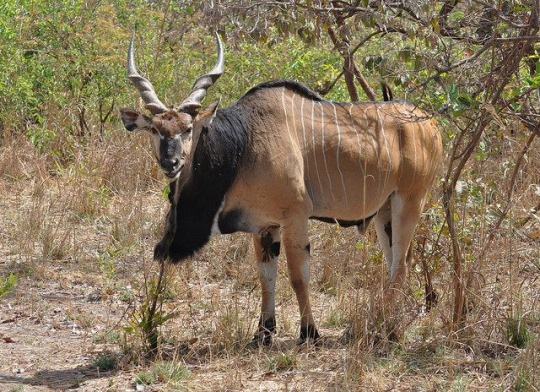
(Photo by Philippe Boissel)
Conservation Status- Critically Endangered
Habitat- Senegal
Size (Weight/Length)- 1,000 kg; 3.5 m
Diet- Grasses; Fruits
Cool Facts- Being the largest species of antelope in both weight and length, the western giant eland is a force to be reckoned with. These giants are non-territorial with small herds being a combination of males and females. During the mating season, mature males separate from their main herd to create a herd of their own. Surprisingly, western giant eland are mostly nocturnal and spend their nights grazing on a variety of grasses. Due to their size and their surprising maximum speed of 70 kilometers per hour few predators outside of large lion prides and saltwater crocodiles have the chance of bringing down an adult giant eland. Sadly, the western giant eland is threatened by illegal poaching for their meat and horns and habitat destruction due to agriculture. Today, conservationists rush to save these beauties through off site breeding and national parks.
Rating- 12/10 (120 centimeter horns backed by 1,000 kilograms of pure muscle.)
#animal of the day#animals#mammals#antelope#wednesday#may 31#western giant eland#eland#biology#science#conservation#the more you know
176 notes
·
View notes
Photo

Western giant eland Tragelaphus derbianus derbianus
Observed by tom_crassard, CC-BY-NC
6 notes
·
View notes
Text
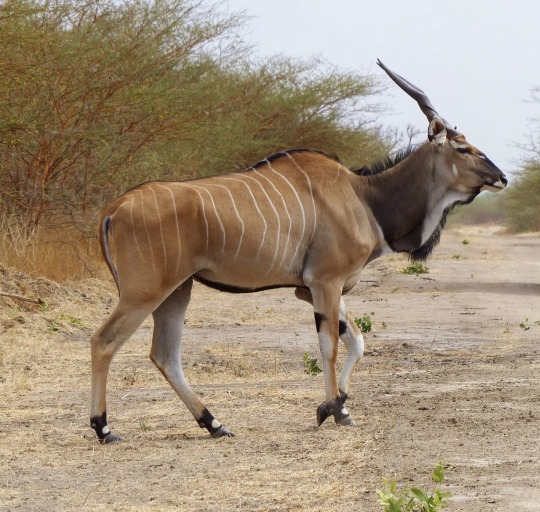
Giant eland (Taurotragus derbianus)
The largest species of antelope in the world, giant eland live in woodlands, savanna, and even deserts of tropical Africa. The two subspecies are found in western and central Africa, respectively. Oddly, female giant elands have one more chromosome than males, because the Y-chromosome has fused with one of the autosomes (karyotype). Because of their adaptations for survival in a dry climate, the related common eland is sometimes farmed instead of cattle!
#markhors-menagerie#animal facts#animals#biology#fun facts#ungulates#even toed ungulates#ruminants#bovidae#antelope#eland#giant eland
6 notes
·
View notes
Text
Western Giant Eland Facts: Habitat, Diet & Pictures

The Western Giant Eland Antelope is a fascinating animal that roams the woodlands and savannas of western and southern Africa. As one of the largest antelopes in the world, these animals can grow up to 6 feet tall and weigh as much as 2,000 pounds. Their long, spiral horns can reach lengths of up to 4 feet and are used for defense against predators and dominance among males.
The Western Giant Eland Antelope belongs to the family Bovidae, which also includes other savanna antelopes such as bushbuck, kudu, and western derby eland. These animals have adapted to living in open grasslands where they can easily spot predators from a distance. They travel in large herds consisting of females, their young, and a few dominant males.
One interesting fact about the Western Giant Eland Antelope is that they have been successfully domesticated in some areas where they are bred with domestic cattle. This has helped to preserve their population while also providing a source of meat for local communities.
Despite being hunted for their meat and horns by humans, these animals are still able to thrive in protected areas such as Niokolo Koba National Park in Senegal. The park provides a haven for many wildlife species including the Western Giant Eland Antelope.
In terms of size, the Western Giant Eland Antelope is considered to be the largest antelope in the world. Their impressive stature makes them an important part of their ecosystem as they play a crucial role in maintaining balance among other animals within their habitat.
Physical Characteristics of the Western Giant Eland
Body Length: Up to 3 meters
The western giant eland antelope is a majestic creature that can grow up to an impressive body length of three meters. This makes them one of the largest species of antelopes in the world. Their long and slender legs, combined with their massive size, make them a sight to behold in their natural habitat.
Their impressive body length allows them to move quickly and gracefully through the grasslands where they live. They are known for their incredible speed and agility, which helps them evade predators such as lions and hyenas. The western giant Eland's large size also gives them an advantage when it comes to finding food.
Weight: Up to 900 kg
The western giant Eland antelope is not only long but also heavy, weighing up to 900 kg. This makes them the largest antelope species in the world. Their weight is evenly distributed throughout their bodies, allowing them to move with ease despite their size.
Their impressive weight also serves as protection against predators that may try to attack them. The western giant eland's physical strength makes it difficult for predators such as lions or hyenas to take down one of these massive creatures.
Coat: Reddish-Brown with Vertical White Stripes
One of the most distinctive features of the western giant eland is its coat, which is reddish-brown with vertical white stripes on its torso and legs. These stripes serve as camouflage in the grasslands where they live, helping them blend into their surroundings and avoid detection by predators.
Male western giant elands have darker coats than females, making it easier for other members of their herd to identify each other during mating season.
Horns: Long Spiral-Shaped Horns
Both male and female western giant elands have long spiral-shaped horns that can grow up to 1.5 meters in length. These horns are used primarily for defense against predators and during mating season to establish dominance over other males.
Their thick and muscular necks allow them to support their heavy heads and horns, which can weigh up to 12 kg. The horns are also used as a visual display during courtship rituals, making the western giant eland an impressive sight to see during mating season.
Strength: Less Vulnerable to Predators
The western giant eland's large size and physical strength make them less vulnerable to predators in their natural habitat. They can defend themselves against most predators with their powerful horns and sheer size alone. Their speed and agility also make it difficult for predators to catch them.
The western giant eland can go for long periods without water, making it easier for them to survive in areas where water sources may be scarce. This combination of physical attributes makes the western giant eland one of the most formidable creatures on the African grasslands.
Habitat and Distribution of the Western Giant Eland
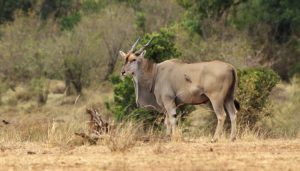
Large Home Ranges
The Western Giant Eland is a majestic antelope species that inhabits savannas, woodlands, and forests. They have large home ranges that can span up to hundreds of square kilometers. This large range is necessary for their survival as it allows them to find enough food and water resources to sustain themselves.
The giant eland's home range varies depending on the season and availability of resources. During the rainy season, they tend to stay in one area where food and water are abundant. However, during the dry season when resources are scarce, they migrate long distances in search of water sources and mineral lick sites.
Natural Habitat
The natural habitat of the Western Giant Eland includes various places across West and Central Africa such as Cameroon, Senegal, and the Democratic Republic of Congo. These areas provide suitable conditions for giant elands to thrive due to their diverse vegetation types and ample yearly rainfall.
In Cameroon, for example, giant elands are found in the Faro National Park, which covers an area of 3,300 km². The park provides a variety of habitats such as savannas with scattered trees, gallery forests along riversides, and valleys with dense forest cover.
Water Sources
Water sources are essential for giant elands' survival; thus they often migrate during the dry season to find them. They need a regular supply of fresh water for drinking purposes but also like to wallow in mud or shallow pools as a way of cooling off from the hot sun.
For instance, in Senegal's Niokolo-Koba National Park during the dry season (November - May), giant elands move towards permanent water sources like streams or rivers located within their home range or outside it if necessary.
Mineral Lick Sites
Mineral lick sites are another crucial aspect of giant elands' habitat as they provide minerals that are not available in their diet. These sites are often naturally occurring and can be found in forests or savannas.
In the Democratic Republic of Congo, for example, giant elands are known to frequent mineral lick sites located near rivers. These licks provide essential minerals such as calcium, sodium, and magnesium that are necessary for their growth and development.
Western Giant Eland Population
The Western Giant Eland population has been declining due to habitat loss, poaching, and hunting. In some areas like Senegal's Niokolo-Koba National Park, their numbers have decreased by more than 80% over the past few decades.
Conservation efforts are being made to protect these magnificent creatures. For instance, Cameroon's Faro National Park has implemented measures such as anti-poaching patrols and community-based conservation programs that involve local people in protecting giant elands' habitat.
Diet of the Giant Eland
Grasses, Leaves, and Shoots: The Main Diet of Giant Elands
Giant elands are known for their massive size and impressive horns. These antelopes are native to the savannas and woodlands of central and western Africa. They are herbivores, which means that they primarily consume plants.
The giant eland's diet consists mainly of grasses, leaves, and shoots. They have a specialized digestive system that allows them to extract nutrients from tough plant materials. They can digest cellulose-rich foods more efficiently than other ruminants like cows or sheep.
However, giant elands also consume a significant amount of woody plants, bark, and fruits. They have been observed eating the leaves and stems of trees such as acacia and baobab. During the dry season when food is scarce, they may even resort to eating roots or digging for water.
Occasional Prey on Common Eland Calves
While giant elands are primarily herbivores, they have been observed to occasionally prey on common eland calves. However, this behavior is not a regular part of their diet. It is believed that they only resort to hunting when food sources are scarce or during periods of drought.
Rich Meat but Endangered Status
The meat of giant elands is rich in nutrients and is considered a delicacy in some parts of Africa. It has been described as having a mild flavor similar to beef but with a slightly gamy taste. However, due to their endangered status, regular intake of their meat is not recommended.
Giant elands face threats such as habitat loss due to human activities like farming and logging. They are also hunted for their meat or trophy horns by humans. As a result, their population has declined significantly over the years.
Ecology and Behaviour of the Giant Eland

Eastern Giant Eland: Ecology and Behaviour
Herbivores of the genus Taurotragus, the giant eland (Tragelaphus derbianus) is a majestic antelope species found in Central and West Africa. The eastern giant eland, also known as Taurotragus derbianus derbianus, is one of the two subspecies and is characterized by distinctive white stripes on its upper forelegs. Here are some interesting facts about the ecology and behavior of this amazing animal.
Giant Eland Herds:
Giant elands are social animals that live in herds consisting of up to 60 individuals, including young elands. These herds may occasionally mix with other species such as common elands or derby elands. Lord Derby's eland is another subspecies of giant eland that can be found in Central Africa.
Ecology:
The ecology of the giant eland is characterized by seasonal migration patterns in search of food and water sources. During the wet season, they move to areas with abundant vegetation for grazing while during the dry season, they migrate towards rivers and other water sources for drinking.
Behavior:
Giant elands are primarily active during the day but may also be active at night when temperatures are cooler. They communicate using a variety of sounds like grunts, snorts, and bellows. Males use their horns to defend themselves against predators or rivals during mating season.
Threats:
Unfortunately, habitat loss due to human activity like deforestation has led to a decline in giant eland populations across Africa. In addition to habitat loss, hunting for meat and trophy hunting have also contributed significantly to their dwindling numbers.
Conservation Efforts:
Efforts are being made to conserve these magnificent animals through various conservation programs across Africa. For instance, protected areas have been established where these animals can live safely without fear of poaching or habitat destruction.
Genetics and Evolution of the Giant Eland
Taurotragus derbianus gigas, commonly known as the western giant eland, is a majestic species that inhabit the savannas and grasslands of West and Central Africa. Here are some interesting facts about its genetics and evolution.
Scientific Name: Taurotragus Derbianus Gigas
The western giant Eland is scientifically known as Taurotragus derbianus gigas. The genus Taurotragus is believed to have evolved around 20 million years ago and is closely related to the bushbuck and kudu.
Exceptional Jumpers
Giant elands are exceptional jumpers and can leap up to 2.5 meters high. This ability allows them to escape predators or cross obstacles such as fences or fallen trees.
Subspecies
The species is divided into two subspecies, the western giant eland (Taurotragus derbianus gigas) and the eastern giant eland (Taurotragus derbianus derbianus). The western giant Eland has larger ears than its eastern counterpart.
Hair Color
Dominant males have black hair while females and young males have brown hair. This difference in hair color helps distinguish between males during mating season.
Reproduction
Giant elands reach sexual maturity at around 2 years old. They have 31 chromosomes in total, which is relatively low compared to other mammals their size.
Evolutionary History
The evolutionary history of the giant eland can be traced back millions of years ago when it first diverged from its ancestors. Over time, this species has evolved adaptations that help it survive in its environment, including its exceptional jumping abilities, large ears for hearing predators approaching from far away, and dark hair color for male dominance displays during mating season.
Threats to the Survival of the Western Giant Eland
Habitat Destruction and Fragmentation
The Western giant eland antelope is an endangered species, with a critically endangered status. The population of the giant eland is declining due to habitat destruction and fragmentation, which has led to small herds. Human activities such as agriculture, deforestation, and urbanization have destroyed the natural habitats for food and shelter. This has caused them to be displaced from their natural range, leading to smaller populations.
Livestock Populations
Livestock populations also pose a threat to the survival of the giant eland, as they compete for resources and can transmit diseases. With grazing lands becoming scarce due to human encroachment into their natural habitats, livestock owners are forced to move their herds into areas where wild animals live. This competition for resources puts pressure on the already dwindling population of giant elands.
Predators
Predators such as lions and hyenas also prey on the giant eland, further reducing their numbers. As these predators continue to hunt for food in areas where human activity has caused habitat destruction and fragmentation, they are more likely to come across smaller populations of giant elands. This puts additional stress on these already threatened animals.
Poisonous Plants
Poisonous plants are also a threat to the giant eland, particularly during the rainy season when they are more abundant. These plants can cause serious harm or even death if ingested by these animals. During periods of drought or when food is scarce, some animals may resort to eating these poisonous plants out of desperation.
Captive Population
To mitigate these threats, a captive population has been established to help preserve the species. However, their life expectancy in captivity is lower than in the wild due to various factors such as lack of genetic diversity and inability to adapt fully to their natural environment once released back into it.
Importance of Conservation Efforts for the Giant Eland
Conservation Efforts for the Western Giant Eland Antelope
Crucial Conservation Efforts
The western giant eland antelope is a majestic animal that is native to West Africa. Unfortunately, their population has been rapidly declining due to habitat destruction and poaching. This is why conservation efforts are crucial in protecting this species from extinction. These conservation efforts include establishing reserves, providing safe habitats, and raising awareness about the importance of protecting these animals.
White Oak Conservation
One organization that has been working towards the conservation of the western giant eland antelope is White Oak Conservation. This non-profit organization provides a safe and natural habitat for these animals to thrive in. They have established breeding programs, which have helped increase the population of these animals significantly. In addition to this, they also work towards educating people about the importance of conserving wildlife and preserving natural habitats.
Establishment of Reserves
Another way that conservation efforts are being made for the western giant eland antelope is through establishing reserves. These reserves provide a protected area where these animals can live without fear of being hunted or losing their habitat due to human activities such as deforestation or mining. The establishment of these reserves has played a significant role in increasing the population of these animals.
Success Stories
Thanks to these conservation efforts, there has been an increase in the population of western giant eland antelopes in recent years. For example, according to reports from White Oak Conservation, their breeding program alone has increased the number of captive-born calves by over 50% since 2019. In addition to this success story, other reserves around West Africa have reported similar increases in populations due to their conservation efforts.
Conservation Status of the Giant Eland
Vulnerable Conservation Status
The western giant eland antelope, one of the largest antelopes in the world, is currently listed as "vulnerable" by the International Union for Conservation of Nature (IUCN). This means that its population has declined significantly, and it is at risk of extinction if conservation efforts are not implemented. The IUCN Red List also recognizes different conservation statuses for the western giant eland antelope in various regions. For instance, it is classified as "endangered" in Senegal and "critically endangered" in Nigeria.
Fathala Reserve's Role
The Fathala Reserve in Senegal has played a crucial role in the conservation of the western giant eland antelope. The reserve has successfully implemented breeding programs and habitat restoration efforts to increase its population. The reserve's success can be attributed to its strong partnership with local communities that have been educated on sustainable management practices.
Population Decline
Despite conservation efforts, the population of the western giant eland antelope continues to decline due to habitat loss, hunting, and competition with domestic livestock. In some countries like Burkina Faso and Niger, they are hunted for their meat or horns. In other areas like Senegal and Mali, their habitat is being destroyed by agricultural expansion and human settlement.
Keystone Species
The status of the western giant eland antelope serves as an indicator of ecosystem health since it is a keystone species that plays a vital role in maintaining biodiversity. Keystone species are vital components within an ecosystem because they maintain balance among other species by controlling populations' growth through predation or competition.
Read the full article
0 notes
Text
7 days Serengeti and ngorongoro crater(mara crossing)
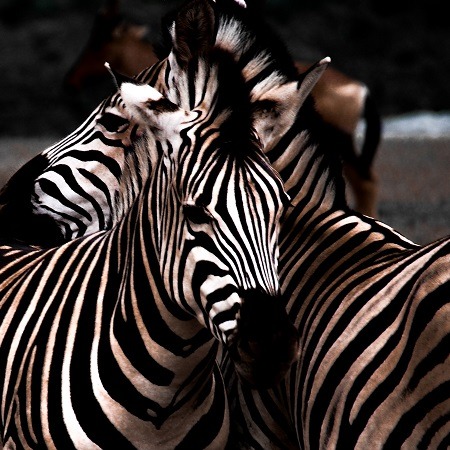
7 days Serengeti and ngorongoro crater(mara crossing)
Great Migration
The journey of the major players in the Great Migration, the approximately two million wildebeest, begins in the southern Serengeti with the birth of half a million young between January and March. A favorite time of year for many of the Serengeti's seasoned guides, the air is teeming with life and action during these months. Read all about Africa's largest wildlife event on this page.7 days Serengeti
OVERVIEW
7 Days Serengeti and Ngorongoro Safari gives you the opportunity to see Ngorongoro Crater/Conservation Area and Serengeti National Park on this 7 Days Tanzania Safari which is a 1 week safari itinerary for Northern Tanzania is to fully explore covers these two parks which are the Great Weights of the Northern Circuit. 7 days Serengeti
Why do wildebeest migrate?
The 800km migration of the giant wildebeest herd is the longest mammalian migration on earth. The timing of the migration coincides with the greening of nutritious grasses in the short-grass plains during the rainy season. These areas are safer as predators can be easily spotted, making them an ideal place to give birth. However, the plains are drying up and the wildebeest are forced to move to the western corridor in search of greener pastures. The northern extent of the ecosystem has the highest
rainfall, but the grasses are the least nutritious.
This is the wildebeest's dry season retreat, at least until the south is green again. The result is a clockwise motion from south, west, north, and back south.
The Great Migration in short
You probably can't find a better representation of the circle of life anywhere else in the world. The journey begins in the southern Serengeti when the wildebeest are born. Predators like lions and hyenas are constantly on the hunt for babies, and thousands upon thousands of pups are born within weeks, eye candy for true nature lovers.
Migration is not without risk: crossing rivers means to face around 3,000 crocodiles patiently waiting to be killed.
Not to mention the Serengeti's famous lion population: by far the largest in Africa. Despite the area's abundance of huffle fish, life for these big cats in this unforgiving landscape is not easy. But seeing a pride of lions working together to hunt a wildebeest is a sight to behold.
Then, with the onset of brief rains in late October, the migration returns the Serengeti back. . In December the herds make their way through Seronera, a small settlement in the central Serengeti
where the official Serengeti Visitor Center is located, to return to their calving grounds and the circle closes.
The Great Migration in detail
When planning your Serengeti safari, you may also want to see the Great Migration. So how do you make sure you're there when it happens? The bottom line is, you can't. It's important to know that deciding when to visit the Serengeti always involves some risk. We've detailed the Great Migration below, and that usually happens, but remember there are no guarantees.
The annual migration of two million ungulates, wildebeest, but also huge groups of zebra and Thomson's gazelle, Grant's gazelle and eland, through the Serengeti National Park is the largest wildlife spectacle of its kind. in Africa and perhaps in the world. Although there is some variation from year to year, the Serengeti migration follows a reasonably predictable annual cycle driven by local rainfall patterns. The Great Migration Cycle is divided into the following periods:
December-April
We find the main breeding grounds in the area southeast of Seronera: the typical Serengeti plains extend into the Ndutu area near Ngorongoro. The short rains in November and December trigger their relocation to this area. The wildebeest stay in this area until the end of the long rainy season, late April, early May. The good news is that this section of Serengeti National Park is easily accessible and the scenery becomes lush during this time. February is usually the calving season of
in the Ndutu area and the south-eastern plains - the best time to visit this area.
Because wildebeest, zebra and other ungulates are so numerous and give birth to so many young, the spectacle acts as a magnet for predators. As early as March or April, the herd can move again in search of greener pastures. It's harder to see actual migration during this period, but you're likely to find very large herds moving.
May-July
During this time, after feeding on the short green grasses of the southeastern Serengeti and giving birth to their young, the wildebeest prepare for their 800-kilometer journey. The actual start date can be anytime between late April and early June. This is the time for you to have the privilege of seeing one of the world's greatest natural phenomena: more than a million animals marching in a column up to 40 kilometers long. During the
migration, the herd will move to the western corridor, where they will encounter their first major obstacle: crossing the Grumeti River. Many animals do not survive the crossing as they are expected to feast on the area's large crocodile population.
The flock may congregate on the south bank of the river and remain there for up to two weeks before crossing the river.
August-September
Once the obstacle of the Grumeti River is overcome, the herd moves further north and in July or August begins crossing the next major obstacle, the Mara River. The Mara River crossing is where so many iconic photos of the Great Migration were taken. After this crossing, the herd moves to the north western plains and the Masai Mara National Reserve in Kenya. August to September is considered a bad time to visit Serengeti National Park to see the Great Migration of
when the herd moves to the Masai Mara in Kenya. However, migration patterns show that about half of the herd stays on the Tanzanian side in the Mara Serengeti area.
During this period, smaller herds of wildebeest (okay, think of it small...herds can number anywhere from 500 to thousands of individuals) frequently cross the Mara River back and forth for no apparent reason. This is an excellent time to stay at one of the Serengeti Mara Camps.
October-November
Crossing the Mara River north means the herd must cross the river once more at one point before making their way back south. This usually happens in October, but sometimes earlier. During this time the herd traverses the northern plains and the Lobo area. This section of Serengeti National Park is rarely visited. So if you want to watch the migration in relative calm, now is the time. The wildebeest return to the short grass plains and calving area
around Ndutu in late November. And from here the Great Migration begins again.
Note
As mentioned above, the times described on this page are guidelines as exceptions are common. In November 2013, the wildebeest were already on their way back to the short grass plains of the southern Serengeti when it suddenly started to rain north of the Mara River. Nature is as nature makes it and the herd turned back to the Masai Mara in Kenya. The herd stayed there for about three weeks before continuing their journey south. A year later, in 2014, unusual rains in the southern Serengeti resulted in much of the herd being left behind and not making the journey north to the Western Corridor until July.
When to visit?
It's a matter of choice if you want to plan your Serengeti safari around the Great Migration. We have already mentioned that the Serengeti is a year-round destination as it covers a vast area and offers unparalleled wildlife viewing. The chances that you are at the exact spot where the Great Migration herd crosses a river (either the Grumeti River or the Mara River) are very slim. The timing of the herd movements cannot be guaranteed either. However, if you choose the right part of the Serengeti
: the South East and Ndutu from December to May, the Western Corridor from May to July, the Serengeti Mara area from July to October and the Northern Serengeti and Lobo area in October and November , large herds of wildebeest and their entourage should be easy to find.
Welcome to tarangire national park
One of the best national parks in Tanzania, Tarangire National Park is situated on the Maasai Steppe to the southeast and the Great Rift Valley lakes to the north and west. The park occupies an area of 2600 square kilometers and is known for a great variety of wildlife species with amazing accommodation options for tourists who can rest when they are on safari tour in Tanzania.
Tarangire National Park is located in Tanzania and is one of the national parks in the Northern Circuit of
Tanzania. This destination is just a short drive from Arusha and close to other wildlife viewing destinations such as Lake Manyara National Park.
The name Tarangire after which the national park is named, comes from the Tarangire River, which flows through the park. Various species of wildlife drink from the river, which is a major source of water for animals, especially during the dry season.
ATTRACTIONS IN TARANGIRE NATIONAL PARK
The remote Silale Swamp is one of the features of the Tarangire ecosystem. During the green season, the swamp acts like a large sponge, absorbing water and slowly releasing it during the dry season. Huge herds of herbivores flood the park in search of water, alternately attracting lion, leopard and wild dog. Silale swamp lions, African wild dogs, buffalo and even elephant call these wetlands home. Donaldson's Nightjar, Smith's Vulturine Guinea fowl are some of the
bird species that can be seen in this area
The giant baobab tree
The baobab tree, popularly known as the tree of life, is another feature found in Tarangire National Park. The baobab has adapted to its environment over time. It's a succulent, meaning it collects and stores water in its massive trunk during the rainy season, allowing it to produce nutrient-rich fruit during the dry season, when all else is dry and barren. Hence it was nicknamed “The Tree of Life”.
It has a “huge”
trunk that can hold up to 300 liters of water.
They have a long lifespan and can live up to 600 years. The edible seeds of this tree are an important source of food for a wide variety of animals. Elephants, on the other hand, sharpen their huge tusks on the bark of these trees. According to legend, these trees could easily migrate across the African continent, but God was irritated by their aimless movement, so he decided to place them upside down so as not to prevent them from moving again.
Birding in Tarangire
Observe a variety of rare and beautiful bird species during your vocation in Tarangire National Park. The Tarangire swamps are home to around 550 different bird species. Tarangire is a well-known safari spot for bird lovers who engage in it for a longer period of time. Crested francolin, hoopoe, yellow-necked swallow, hornbill, guinea fowl, steppe eagle, brown parrot, giant lappet vulture, white-bellied vulture,
bird, Bateleur's eagle, mouse birds, kori bustard, yellow-necked turtledove, bee-eater are some of the bird species that you can spot during your safari in Tarangire-Tanzania.
The Wildlife Migration in Tarangire
Tarangire is one of the most seasonal parks in northern Tanzania, with much migratory activity within the Tarangire area. Tarangire is about 120 kilometers from Arusha, near the southeast corner of Manyara National Park.
During the dry season, from June to October, mostly The Tarangire region is completely dry and there are only a few water sources. Incredibly large herds of various animals migrate to the park as they are drawn to the waters of the Tarangire River
. While not as well known as the annual migration of ñus in the Serengeti, this massive wildlife migration sees elephants, antelope, ñus, gazelles and more Zebras, as well as predators such as lions and leopards, enter the park in large numbers.
Make this park a part of your North Tanzania Safari as the vegetation is sparse and dry which is an excellent Allows wildlife observation.
Tanzania’s elephant population
The largest elephant population in Tarangire National Park, which is said to be the highest in Tanzania, is one of the Main attractions that helped him become world famous. As the dry season unfolds from June to October and the terrain becomes drier and drier you will encounter large herds of elephants of up to 300 elephants seeking the dry bed of the Tarangire River in search of underground water streams to quench their thirst. The arrival of the rains in
, on the other hand, provided plentiful pasture and water, causing animals to scatter throughout the park. However, due to the large number of elephants that live here, these land giants can also be seen during the rainy season.
Poacher’s Hide
Poacher Hide in Tarangire National Park is a must-see attraction. It is located southwest of Tarangire Hill, about a hundred meters west of the park's main north-south road. The Poacher's Hide is a famous ancient baobab tree with a slightly hidden entrance and an inner chamber previously used as a hiding place for poachers. The poacher's skin baobab is around 10 meters in diameter and believed to be over 300 years old, making it one of the
oldest trees in Tarangire National Park.
Lemiyon Triangle
This is another attraction to see during your safari in Tanzania Tarangire National Park. Huge baobab trees and huge flocks of red-billed quelea birds can be found in Lemiyon. This pristine site is located at the north end of the park and forms a triangular area. The most striking vegetation here are the giant baobabs that line the road with their colossal silver trunks and multitude of gnarled branches. Lemiyon is excellent for spotting raptors, and even non-bird watchers will be surprised by the numbers of these powerful aerial carnivores.
Tarangire River
The Tarangire River is an important feature in Tarangire National Park. It serves as a water source for the park's ecosystem and is a fantastic spot for wildlife viewing as animals congregate on the banks of the river to drink water, especially during the dry season. .
On Tanzania wildlife viewing safaris in Tarangire National Park, the Tarangire River is a sanctuary for many animals including a sizeable concentration of elephants that come to the banks of the river, to drink water
and cool off from the scorching sun. Elephants have been seen digging in the sand near the Tarangire River to fetch water from the ground. Leopard, lion, wildebeest, zebra, buffalo and gazelle are among the creatures that can be spotted along the banks of the Tarangire River.
Matete Woodlands
Mateteo offers excellent leopard viewing opportunities as well as the chance to catch a glimpse of the rare gemsbok. The towering elephant grass and prickly sedges that grow along the riverbanks on the western side of the region give the place its name. Matete is the best place in the park to regularly see leopards. These reserved cats are often seen among the branches of tortilla acacia trees.
Kitibong Hill
KitibongHill is a stunning area in Tarangire National Park that is home to huge herds of cape buffalo and endangered wild dogs. During a Tanzanian safari in Tarangire National Park, you can see Cape buffalo brandishing their massive horns and roaming the area's acacia plains.
The spectacular African wild dogs, which run in groups from 6-20 in this area of Kitibong Hill. Travelers who visit Tarangire National Park while on safari in Tanzania have
opportunities to see and learn about these attractions in the park surroundings. For a truly unforgettable safari experience in Tanzania and Africa, choose Focus East Africa Tours to take you on a safari to Tarangire National Park.
0 notes
Photo

(Note: I am not a professional paleontologist or even biologist. I am just and amateur paleoartist and enthusiast. If my infos are off in some way, feel free to correct them ^^)
-
DINOCEMBER
3 - Zuul crurivastator (tribute to Zuul, the Gatekeeper of Gozer, from the Ghostbusters franchise; "crurivastator" comes from the Latin "shank destroyer")
- Late Cretaceous (75 Ma BCE)
- Judith River Formation, Montana, US
Formally named in 2017, Zuul is one of the most fantastic findings of recent years, being the most complete ankylosaur fossil in North America, preserving about 99% of the 6 meters-long animal's skeleton, as well as impressions of skin and the keratinous cover of its osteoderms in their life position, as well as his skull, which earned him his name, and the heavy bony club of the bridge of his tail, which earned him the nickname "Destroyer of Shins", based on what is believed to be the form of defense of this animal when using the club on its predators. The Judith River Formation, like many others rich in fossil extract, represents a coastal plain on the west bank of the Western Interior Seaway, which divided North America during the Cretaceous into two continental masses, Laramidia and Appalachia. In addition to Zuul, several hadrosaurs and ceratopsians are present in the region, as well as tyrannosaurs, raptors and crocodylomorphs, including the immense Deinosuchus, one of the largest that has ever existed.
Ankylosaurs like Zuul were large plant-eaters that inhabited the Northern Hemisphere during the Cretaceous, being more dominant in certain regions of Asia, where they were apparently the main herbivores, while hadrosaurs dominated North America, being herbivores that ate plants closer to the ground, like bushes, small cycads and ferns, often being considered frugivorous, since the flowering plants and fruits started to appear near the end of the Cretaceous, which was something I decided to portray here, not excluding the possibility of some fruits having a hallucinogenic effect and affecting the hungry dinosaur, similarly to what happens with elephants when they feed on the fruits of the amarula, which naturally ferment when they fall from the tree, causing a drunken state in the animal.
- Color scheme based on a Giant Eland (Taurotragus derbianus)
#dinocember#dinocember2020#ankylosaur#zuul crurivastator#Zuul#I am Zuul. I am the Gatekeeper#ornithischia#thyreophora#ankylosaurini#ankylosauridae#Laramidia#late cretaceous#sciart#science illustration#paleobiology#paleontology#paleoart#paleoillustration#nature#art#Digital Artists#artists on tumblr#digital drawing#digital art#creature concept#creature art
48 notes
·
View notes
Text
the signs as animals
arist: south african cheetah
aries: american black bear
argo: kordofan giraffe
arga: griffon vulture
arittanius: wildebeest
arittarius: yak
arpio: bowhead whale
arpia: african elephant
arlo: horse
aro: barn owl
ara: tiger
arza: white rhinoceros
aricorn: spider monkey
ariborn: ring-tailed lemur
arnius: tabby cat
arius: megabat
asci: rock dove
asces: pied crow
armino: lion
armini: eurasian wolf
arcer: gerbil
arcen: newt
arus: bush-tailed porcupine
arun: philippine forest rat
taurrist: asiatic cheetah
taurries: asian black bear
taurgo: nubian giraffe
taurga: cinereous vulture
taurittanius: roan
taurittarius: southern marsupial mole
taurpio: right whale
taurpia: asian elephant
taurlo: sea eagle
tauro: grass owl
taurra: sheep
taurza: sumatran rhinoceros
tauricorn: vervet monkey
tauriborn: aye-aye
taurnius: jungle cat
taurrius: flying fox
taursci: trocaz pigeon
taursces: american crow
taurmino: kit fox
taurmini: tundra wolf
taurcer: guinea pig
taurcen: seal
taurus: crested porcupine
taurun: nile rat
gemrist: north american cougar
gemries: atlas bear
gemgo: west african giraffe
gemga: white-rumped vulture
gemittanius: waterbuck
gemittarius: northern marsupial mole
gempio: blue whale
gempia: blue-ringed octopus
gemlo: snake-eagle
gemo: sooty owl
gemra: argali
gemza: black rhinoceros
gemicorn: proboscis monkey
gemiborn: sifaka
gemnius: european wildcat
gemrius: egyptian fruit bat
gemsci: laurel pigeon
gemsces: cape crow
gemmino: red fox
gemini: arabian wolf
gemcer: dove
gemcen: house mouse
gemus: long-tailed porcupine
gemun: moluccan prehensile-tailed rat
canrist: florida panther
canries: blue bear
cango: reticulated giraffe
canga: black vulture
canittanius: eland
canittarius: golden mole
canpio: bryde’s whale
canpia: dumbo octopus
canlo: black-chested buzzard-eagle
cano: itombwe owl
canra: mouflon
canza: indian rhinoceros
canicorn: pygmy marmoset
caniborn: mouse lemur
canius: black-footed cat
canrius: california leaf-nosed bat
cansci: hill pigeon
cansces: hooded crow
canmino: cape fox
canmini: steppe wolf
cancer: humming bird
cancen: mayor’s moue
canus: bristle-spined rat
canun: bulldog rat
lerist: african leopard
leries: eurasian brown bear
lego: angolan giraffe
lega: turkey vulture
leittanius: gerenuk
leittarius: eurasian beaver
lepio: fin whale
lepia: mimic octopus
lelo: black solitary eagle
leo: bay owl
lera: urial
leza: nile hippopotamus
leicorn: rhesus macaque
leiborn: cockatiel
lenius: sand cat
lerius: hondurian white bat
lesci: snow pigeon
lesces: somali crow
lemino: arctic fox
lemini: mongolian wolf
lecer: flying squirrel
lecen: sikkim mouse
leus: prehensile-tailed porcupine
leun: kerala rat
virrist: javan leopard
virries: eurasian brown bear
virgo: south african giraffe
virga: california condor
virittanius: steenbok
virittarius: north american beaver
virpio: see whale
virpia: blanket octopus
virlo: crested eagle
viro: scops owl
virra: bighorn sheep
virza: east african hippopotamus
viricorn: gibbon
viriborn: parrotlet
virnius: chinese mountain cat
virrius: big brown cat
virsci: specled pigeon
virsces: flores crow
virmino: fennec fox
virmini: dingo
vircer: unstriped ground squirrel
vircen: volcano mouse
virus: electric eel
virun: himilayan field rat
librist: northern goshawk
libries: grizzly bear
libgo: masai giraffe
libga: greater flamingo
libittanius: nyala
libittarius: star-nosed mole
lipio: chilean dolphin
lipia: coconut octopus
liblo: harpy eagle
libo: screech owl
libra: thinhorn sheep
libza: cape hippopotamus
libicorn: bornean orangutan
libiborn: caique
libnius: amazon weasel
librius: dwarf epaulettes fruit bat
libsci: wood pigeon
libsces: bismark crow
limino: grey fox
limini: dog
libcer: indian palm squirrel
libcen: indian field mouse
libus: hog-nosed skunk
libun: sunburned rat
scorrist: gray-bellied hawk
scorries: east siberian brown bear
scorgo: thornicroft’s giraffe
scorga: lesser flamingo
scorittanius: klipspringer
scorittarius: hairy-tailed mole
scorpio: arabian dolphin
scorpia: giant squid
scorlo: papuan eagle
scoro: snowy owl
scorra: snow sheep
scorza: west african hippopotamus
scoricorn: sumatran orangutan
scoriborn: lorikeet
scornius: mountain weasel
scorrius: split-nosed bat
scorsci: comoros olive pigeon
scorsces: white-necked crow
scormino: swift fox
scormini: tibetan wolf
scorcer: eastern grey squirrel
scorcen: ryukyu mouse
scorus: hooded skunk
scorun: aceh rat
sagirist: red-chested goshawk
sagiries: syrian brown bear
sagigo: pig
sagiga: chilean flamingo
sagiittanius: kudu
sagiittarius: eastern mole
sagipio: long-beaked dolphin
sagipia: colossal squid
sagilo: balck eagle
sagio: great horned owl
sagira: red kangaroo
sagiza: angola hippopotamus
sagiicorn: tapanuli orangutan
sagiiborn: parakeet
saginius: steppe polecat
sagirius: brown long-eared bat
sagisci: white-naped pigeon
sagisces: jungle crow
sagimino: plains bison
sagimini: japanese wolf
sagicer: colorado chipmunk
sagicen: cook’s mouse
sagius: striped skunk
sagiun: snake
capririst: besra
capriries: giant panda
caprigo: chicken
capriga: jame’s flamingo
capriittanius: lechwe
capriittarius: gansu mole
capripio: killer whale
capripia: humboldt squid
caprilo: spotted eagle
caprio: eagle owl
caprira: eastern grey kangaroo
capriza: north american ostrich
capriicorn: eastern gorilla
capriiborn: pianos parrot
caprinius: long-tailed weasel
capririus: mediterranean horseshoe bat
caprisci: stork
caprisces: fish crow
caprimino: wood bison
caprimini: indian wolf
capricer: grey-collard chipmun
capricen: cypriot mouse
caprius: spotted skunk
capriun: spider
aquarist: long-tailed hawk
aquaries: sloth bear
aquago: red junglefowl
aquaga: andean flamingo
aquittanius: springbok
aquittarius: long-tailed mole
aquapio: pilot whale
aquapia: japanese flying squid
aqualo: tawny eagle
aquo: fish owl
aquara: western grey kangaroo
aquaza: masai ostrich
aquicorn: western gorilla
aquiborn: cockatoo
aquanius: yellow-bellied weasel
aquarius: raccoon
aquasci: goose
aquasces: house crow
aquamino: european bison
aquamini: arctic wolf
aquacer: gray-footed chipmunk
aquacen: steppe mouse
aqus: fattail scorpion
aqun: alligator
pirist: chanting goshawk
piries: polar bear
pigo: cow
piga: american flamingo
piittanius: sable antelope
piittarius: japanese shrew mole
pipio: houglass dolphin
pipia: vampire squid
pilo: camel
pio: spotted wood owl
pira: antilopine kangaroo
piza: arabian ostrich
piicorn: chimpanzee
piiborn: conure
pinius: european mink
pirius: koalas
pisci: duck
pisces: palm crow
pimino: water buffalo
pimini: baffin island wolf
picer: uinta chipmunk
picen: meerkat
pius: pandinus
piun: crocodile
#homestuck#zodiac#extended zodiac#the signs as#long post#originality is overrated#i spent way way way way too long on this thing
671 notes
·
View notes
Text
Hakuna Matataland
I was never particularly tempted by Africa, thinking it’s just a desert with little food and little to see. Nothing of that turned true – variety of landscapes, comfortable temperature, numerous animals, friendly locals and clean public spaces can satisfy even the most critical tourist.
Honza tricked me into a holiday in Tanzania by showing the pictures of Zanzibar’s sandy beaches:

Can one say no? :) As a compromise, we decided to spend a week on the continental part for a safari, and then chill in Zanzibar for another week – which I would say is the perfect mix for a comprehensive holiday.
After few hard months at work, we both just slept through the 14 hours of flight with a quick lunch in Istanbul, and woke up in Dar es Salaam - the former capital and largest city in Tanzania. Over the last century, Dar es Salaam has grown from a sleepy fishing village into a metropolis of over four million people. Straddling some of the most important sea routes in the world, it is East Africa’s second-busiest port and Tanzania’s commercial hub. Despite this, and its notorious traffic jams, the city has managed to maintain a low-key down-to-earth feel.
We stayed at the local Backpacker’s hostel owned by a distant acquaintance of ours, who did a city tour for us. It was pretty much just about walking around in a crowded slum-like city center, sweating at every step. The highlight was a metro trip (metro meaning bus run on tracks) and a visit to the local fish market. Boiling hot and rich in smells, it is divided into two main sections, with fresh and less-fresh fried fish sold to the local shoppers and restaurants.

Luckily, we escaped from Dar just after a day, and flew to Arusha, the gateway to the popular Northern Safari Circuit. Nested at the foot of Mount Meru (the view on which we enjoyed from the terrace of our guesthouse with a glass of wine), it is a lush green town as opposed to the dirty Dar. From some points of the area, you could even (theoretically) see Kilimanjaro - but it was always hiding in the clouds.

Here, we had a local buddy called Colman, who helped us book the safari, took us to the dinner with his friends and organized a trip to the Hot Springs (also with five of his friends). This is a fantastic oasis in the middle of nowhere. The term "Hot" in hot spring is used quite loosely though - the water was warm at best, but very clean. The fishes munch at the feet all over, just like at the Thai massage places. There is a swinging rope to either embarrass yourself (me) or show off your monkey skills (Honza), and a little stall with suspicious yet nutritious French fries omelet.

Next day, we took off for the adventure! The first destination was Tarangire National Park in northern Tanzania. Hump-backed wildebeest, kongoni with long ears and short horns reminiscent of a samurai headdress, hulking buffalo, buxom zebra, delicate gazelles, watchful eland, ostrich outriders, fringe-eared oryx and an array of predators move in and out of the park in different directions at different times. Starting with happy shouting when we see one lonely animal here and there, we were soon used to the herds of zebras and the whole elephant families gathering in central riverbeds. One more amazing sight were the giant baobab trees, medusa-headed monoliths often thousands of years old, making the scenery picturesque.
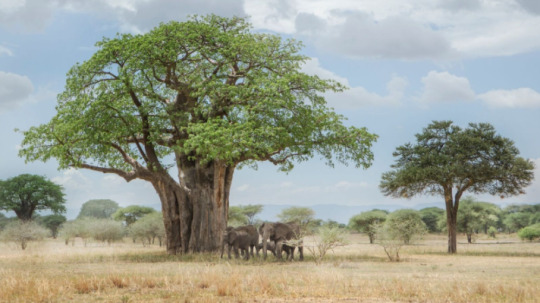

The first night out was in an African igloo at Panorama lodge. It has a stunning view on the savanna, and a storm was coming around in the evening. We enjoyed a dinner cooked by the group’s chef, scaring the lizards away from our plates.
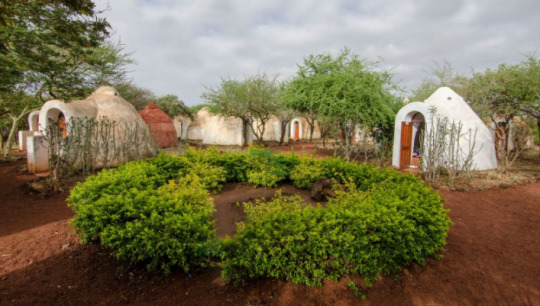
We were in a group of five: two of us, a hot 40-y.o. American, and two German-Italian guys, in an indestructible Land Rover Defender, led by an amazingly calm guide Abdul, who’s been doing this for over 15 years. His personal lifetime safary experience was when a family of lions were passing through the camp and a baby got stuck in his tent, crying for mommy’s help. Abdul also helped me get my own personal lifetime experience of getting out of the jeep to pee in the middle of the savanna (strictly prohibited and deadly) few kms away from the lions.

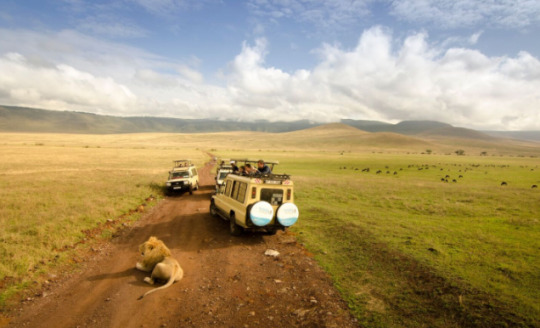
The next park was THE Serengeti. With nature ranging from apparently limitless grass plains in the south, fertilized by volcanic ash, to wooded highlands in the east, crossed by rivers, it is a home to hundreds of inhabitants.
Among them, the principal actors are blue wildebeest and their spectacular annual Great Migration, “The Greatest Show Of The Natural World”, during which they trek in circumambulation for 3200 kilometers from northern Tanzania to south-western Kenya and back again. In turn, their trips affects other creatures: lions, jackals, hyenas, leopards and cheetahs prey on the migrating and resident herds. Vultures subsist on the predators’ leavings.
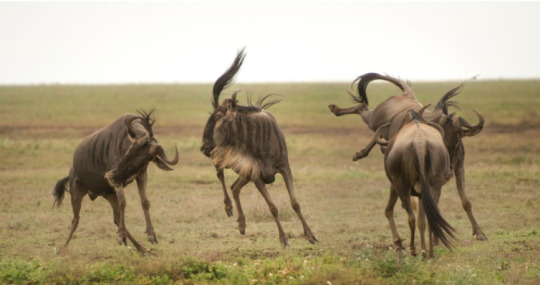
The herds of zebras were mainly turning their butts on us, but still were magical. Over the course of the safari, the amount of zebras around us was growing exponentially, until on the last night in Ngorongoro camp our tents were surrounded by them, walking between the tents. This was quite nice, as opposed to SImba camp in Ngorongoro, with hyenas swinging around and laughing right in your ear at night.
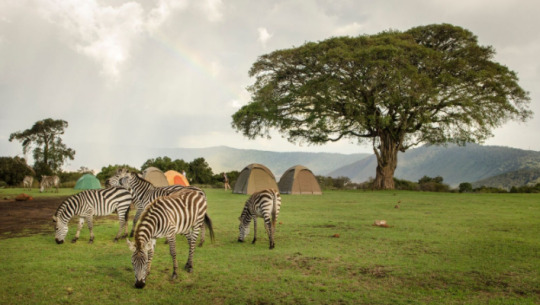
Ngorongoro is a park located in a volcano crater, with the diameter of over 20 km. This is a whole magical world, with own ecosystem, salty lakes, humid jungle forests and green swamps. The camp was based on the top of it, and at dawn we were descending for about 2 kms down on a dusty narrow road, speechless from the views unfolding ahead of us.

We’ve seen graceful flamingos, supposedly pink because of the shrimps they eat.
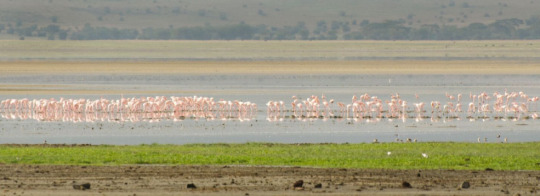
The swamps were full of grey dirty rocks that turned out to be sleepy hippos, nocturnal thus not giving a damn about the birds jumping all over them.

As for me, if you just have one day, Ngorongoro is the most magical place to see on the mainland.
Tired and dusty, we returned to Arusha to fly to Zanzibar on the next morning. Local airlines are truly a miracle, where ‘hakuna matata’ principle rules over any regulations. The boarding passes are issued in handwriting, and our surnames were (understandably) way too difficult for the check-in guy – so we ended up with two pieces of paper stating ‘Jan’ and ‘Daria’, and a delay of just two hours.
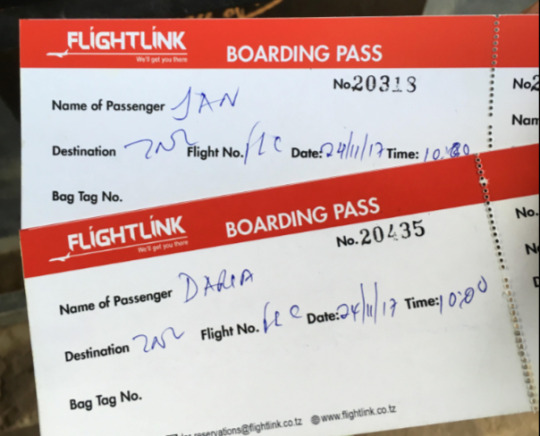
The plane had about 10 seats, so it’s almost as if you had a luxury private jet. By the way, there’re at least three different airlines, with ticket price varying from roughly 70 to 370$ for the same route – we dared to go with the cheapest and it was absolutely fine.
Zanzibar lies on the east coast of Africa, and the name officially refers to the archipelago that includes Unguja and Pemba, surrounded by about 50 smaller ones. As we were explained, when mere silly Europeans say ‘Zanzibar’, they usually refer to the Island of Unguja, separated from mainland Tanzania by a shallow channel 37 km across at its narrowest point.

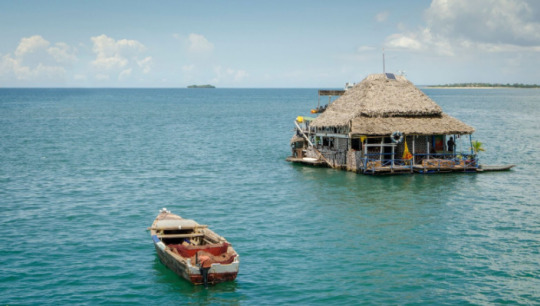
Zanzibaris have a long history of religious tolerance and although the islands are 95% Muslim, alcohol and tobacco are available (if you search for it: not in every hotel, but pretty much in every bar). The tourists are many, and they are requested to show consideration for the Zanzibari culture by wearing long skirts/pants and covering the shoulders.
For many centuries there was intense seaborne trading activity between Asia and Africa, and Zanzibar was a key African port, hosting and blending the culture of Germans, Indians and Omanis. It used to be a colony of Oman for quite a while, and has become an official part of Tanzania quite recently, in 20th century. The name of the country itself is actually made up from two words: ‘Tanganyika’, the name of the continental part, and ‘Zanzibar’.
Zanzibar has great symbolic importance in the suppression of slavery, since it was one of the main slave-trading ports in East Africa. Interestingly, the majority of slaves were female concubines, whose children had full inheritance rights, same as the marital children of the master family. After a concubine gave master a child, it was impossible to sell either – which I can imagine resulted in an interesting blend of relationships and a blurred perception of social stratification.
The last but not the least important historical fact is that their beloved Princess Salme, who published an extensive memoir on her life in Zanzibar, looked like Putin. So we bonded with the locals immediately.

The capital and the main port is Stone Town, home of Freddy Mercury (Muslim locals do not seem especially proud of it, though).
The historic center is essentially a labyrinth of narrow winding streets, all leading to the sea cost, where local children play and swim right between the boats.
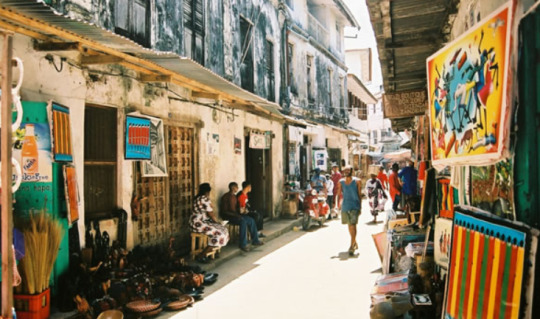
The city has a very calm vibe, and for the first time in Tanzania I felt truly comfortable and relaxed strolling around. One drawback is that obviously the prices are rather European – but fresh juices and local foods are worth it.
Zanzibar is sometimes called ‘the Spice Island’, as the agriculture is focused on growing spices. We decided to explore on of the local spice farms. Turns out, pretty much everything we know - cloves, cinnamon, nutmeg, vanilla, cardamom – grows on trees and bushes. Africans do not really use much spices for food, which is rather flat in terms of taste – but their traditional medicine is all about spices. Eating cumin powder helps with ‘running stomach’ (tested, proven personally), nutmeg gives women ‘romantic eyes’ and enhances men’s power (according to an alternative source, it can keep you high for up to 24 hours), and eating henna roots that cause internal bleeding has been an abortion solution for the most conservative Muslim communities for centuries.
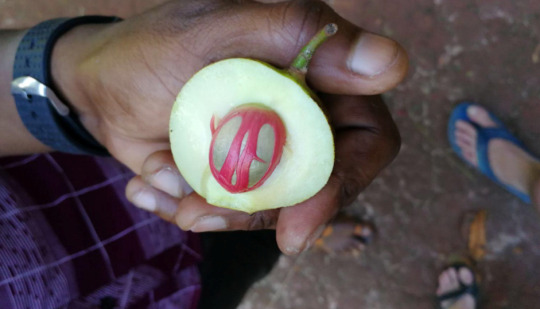
After the farm tour, we did a local cooking class – fish curry, spinach mash and coconut milk dumplings with cardamom, all cooked right on the floor and eaten mostly by the local village kids attracted by the smell. If we did not see that fish on the local market, I suspect we might’ve enjoyed it more. But the dumplings were dope, and burnt cane sugar with cardamom is something you should all try!

After Stone Town, we headed to the north-east of the island for beaches and dives. Our first stop for few days was Kiwengwa, which, funnily enough, turned out to be an Italian enclave. Somehow the first tourists that started coming to Zanzibar about 10 years ago were Italians, and all the locals started learning the language. More than a half of the beach cafes were serving pizza, pasta and Prosecco (not that I mind!), and local kids were chasing us on the beach shouting ‘Ciao bella’. The beach souvenir stalls with coconut carvings and textile bags had the proud names like ‘Dolce & Gabanna” and “Fendi”.
The sea life was absolutely stunning. We skipped the crowded dolphin-chasing tours and went diving and snorkeling to the tiny neighboring islands. My personal favorite was a trumpet fish:
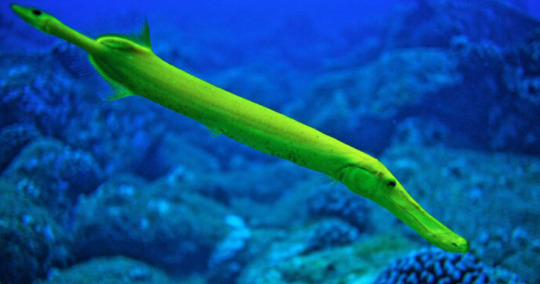
And apart from that, there was absolutely nothing to do in the north-east, as there was no wind and no waves. I was counting with sunbathing all day long, however, the tan plan was usually fulfilled in the first 15 minutes at the beach, even with SPF 50: African sun is truly severe. Chilling in the shadow of hotel terrace was complicated by the hardworking waiters, who came every 10 minutes with a call-center dialogue script: “-Hello! -…. ‘How are you?’ ‘… ‘How is your day?’ … ‘Is everything okay?’… ‘Would you like something else?’ ‘… and a killer follow-up ‘Why not?’. When once I dared not to order a drink, one of the waiters literally chuckled, loudly expressing her contempt for my refusal to support the local economy.
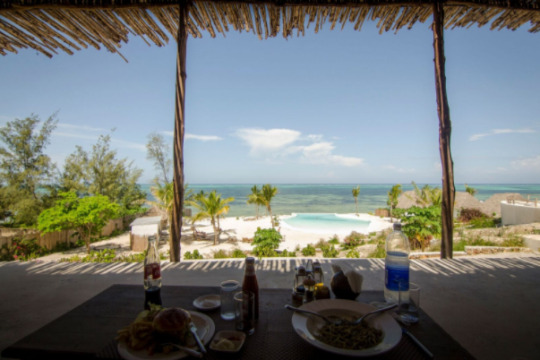
After three days, we ran away to Paje, a more democratic party village on the east coast. There was a tiny bit of wind, still not enough for surfing but sufficient for trying out a kite. This kept Honza busy for another two days, while I was swallowing Agatha Christie’s novel in batches. A sport that needs independent coordination of legs and hands did not look very promising for me. And the beaches were just amazing 24/7.

When it was time to go home, we took a ferry from Stone Town to Dar – and despite many negative reviews, I would recommend it to everyone. Reasonably priced (35$), big, clean and air conditioned, it reaches Dar in just about 2 hours – and then you can uber to the airport. Just be aware that local drivers aren‘t big believers in driving after they accept the order – they usually just stay where they are, apparently waiting for you to come to them. It took us just half an hour with 2 phones to actually get a car – but it was about 30 times cheaper than a taxi for an hour’s drive.
A lonely plastic pine tree in the departure hall reminded us that we’re flying back for snow and Christmas. This is nothing personal for Africa, but it was amazing to be back, with the reliable electricity supply, drinkable tap water and no need to bargain over everything.
Some of the practical tips:
· Essential vaccinations are just two – typhus ans yellow fever, but you must have a vaccination certificate for border crossing.
· If customs officers go away for half an hour with all your documents – hakuna matata. Sooner or later they’ll come back, and even if you end up with few local loans on your name, the notifications are not likely to arrive overseas.
· Mosquito net was available everywhere we stayed, but we still took one with us just in case. You’ll be bitten anyway, even with the net and repellent – but the levels of malaria are very high on the continental part.
· If you take Malarone in the evenings together with red wine, your dreams will be vivid and complex.
· If going in the low season as we did, you should definitely book a safari right on the spot in Arusha. This is more than twice cheaper than booking online in advance, and options are plenty. I’ll be happy to refer our local buddy to you :)
· Make sure you go to the bathroom before sleep when you stay in safari camps to avoid unpleasant meeting with hyenas. Same stands for game drives, when you are technically not allowed to leave the car. Skipping on this results in the scariest two minutes of your life, especially if someone in the crew decided to fool you shouting „Look, lion is coming!“ while you’re out.
· By law visitors have to settle bills in US dollars rather than shillings, but no one really cares. It;s best to bring USD and withdraw some local currency just in case. When paying in USD, you can (should) bargain over the exhange rate!
· As usual – avoid raw foods, veggies and fruit that you do not peel yourself, and make sure your water bottles are sealed. Valid even for the five-star hotels. If anything, chew cumin.
· Chat with the locals, smile and hakuna matata! Once you let it all go, Africa is amazing!
2 notes
·
View notes
Text
6 DAYS TANZANIA BUDGET TENTED CAMPS SAFARI

6 DAYS TANZANIA BUDGET TENTED CAMPS SAFARI
6 DAYS TANZANIA BUDGET TENTED CAMPS SAFARI with Kilipeak Adventure, We offer unique and affordable safaris through northern Tanzania’s most famous national parks and conservation areas. We arrange a wide range of safari itineraries with various lodging choices to suit any schedule. All our safaris use extended Land Cruisers with roof hatches for unobstructed and up-close game-viewing. Our safari itineraries include all park fees, an English speaking driver/guide, meals, and lodges.
DAY 1: ARRIVE IN TANZANIA.
You will be picked up from the Kilimanjaro airport and taken to your hotel in Arusha for dinner and overnight. Accommodation at Maasailand Safari Lodge: Bed and Breakfast.
DAY 2: ARUSHA-LAKE MANYARA.
Pick up from Arusha and transfer to Lake Manyara national park. We arrive in time for lunch at the lodge and after lunch does we head into the Lake Manyara National Park for an afternoon game drive. This national park is one of Tanzania’s most dramatically located wildlife areas, consisting of a massive but shallow soda lake (covering two-thirds of the park), located at the foot of the Great Rift Valley’s western escarpment. The park’s varied habitat attracts a wide variety of animals, including one of Africa’s largest concentrations of elephants, Lake Manyara’s unique tree-climbing lions, as well as large flocks of flamingos attracted by the algae in the Lake.
Accommodation at Migunga Tented Camp: full board.
DAY 3: LAKE MANYARA-SERENGETI PLAINS.
After breakfast, we head towards the Serengeti National Park, via the beautiful high lying farmland of Manyara and the Ngorongoro Conservation Area. Leaving the highlands behind, we descend into the heart of wild Africa – the Serengeti National Park – with its endless plains, rolling into the distance as far as the eye can see. We head to the central park area, known as the Seronera area, one of the richest wildlife habitats in the park, featuring the Seronera River, which provides a valuable water source to this area and therefore attracts wildlife well representative of most of the Serengeti’s species. We arrive in time for lunch and enjoy an afternoon game drive in the Serengeti national park.
Accommodation at Serengeti Heritage Tented Camp: full board.
DAY 4: SERENGETI PLAINS.
Be one of only a few fortunate people to glide in a Hot Air Balloon over the Serengeti Plains (available at supplementary cost by pre-arrangement). Floating silently above the awakening bush, while spotting wildlife and enjoying the amazing scenery of Africa, across rivers and over numerous small villages.
We do an after breakfast game viewing drives along the Sogore River Circuit, which loops into the plains south of the Seronera River, and which is good for possible Lion, Thomson gazelle, topi, ostrich and cheetah sightings. The Visitor Center close to the Serengeti Seronera Lodge and public campsites is well worth a visit after the morning’s game drive. This nicely designed center offers some interesting wildlife displays as well as a gift shop selling information leaflets and maps of the area. The center also has a shop where cold drinks and snacks can be purchased, as well as a picnic area and information trail up and around a nearby kopje. We will enjoy a relaxed picnic lunch at the center in the shade of the giant acacia trees.
In the afternoon we will follow the Kopjes Circuit, which goes anti-clockwise around the Masai Kopjes, which usually attracts a number of lion and some formidably large cobras. Kopjes are weathered granite outcrops, scattered around the plains, most of which are miniature ecosystems, providing shade and drinking water in pools left in the rock after the rains. This makes the kopjes particularly good for spotting wildlife in the dry seasons – including lions, which like to lie in wait for animals coming to drink!.
Accommodation at Serengeti Heritage Tented Camp: full board.
DAY 5: SERENGETI PLAINS-NGORONGORO CRATER.
After breakfast at the lodge, we depart to Ngorongoro Conservation area. We will stopover at Olduvai Gorge, boasting with a history dating back to the dawn of time. It was here, that the anthropologists Drs. Lois and Mary Leakey discovered the skulls of ‘Nutcracker Man’ and ‘Handy Man’, both very significant links in the chain of human evolution.
We arrive in time for lunch at the lodge and after lunch, we will descend over 600 meters into the crater to view wildlife for a half day’s safari tour. Supported by year-round water supply and fodder, the Ngorongoro National Park supports a vast variety of animals, which include herds of wildebeest, zebra, buffalo, eland, warthog, hippo, and giant African elephants. Another big draw card to this picturesque national park is its dense population of predators, which include lions, hyenas, jackals, cheetahs, and the ever-elusive leopard, which sometimes requires a trained eye to spot. We will visit Lake Magadi, a large but shallow alkaline lake in the southwestern corner, which is one of the main features of the crater. A large number of flamingos, hippos, and other water birds can usually be seen here.
Accommodation at Ngorongoro Rhino Lodge: full board.
DAY 6: NGORONGORO CRATER-ARUSHA.
Enjoy breakfast, after which transfer back to Arusha. Upon arrival in Arusha will we have lunch and then we will end our African safari adventure. You will be taken to your hotel, dinner and overnight at the previous hotel.
Accommodation at Maasailand Safari Lodge: half board.
E-mail us at any time to discuss your trip and get an accurate quotation.
SAFARI INCLUDES:
1. Full board accommodation whilst on safari in the above-mentioned lodges
2. Private safari guide
3. Private 4 x 4 safari jeep with pop up roof for game viewing
4. Transfers in both directions between the International Airport
5. Park fees
6. Crater fees
7. All meals whilst on safari
8. Airport Arrival/Departure Meet and Greets at the airport
9. On safari – Vehicles equipped with ice chest with mineral water, wildlife guidebooks.
10. Government taxes, VAT and service charges relating to accommodation and included meals
SAFARI EXCLUDES:
11. Tanzania Visa: $50 per person on arrival, USA and Canada passport holders USD.100
12. Personal Expenses (e.g. laundry, telephone, beverages, etc.)
13. Meals not listed above
14. Optional Tours (balloon rides USD. 550 per person etc)
15. Tips and any items of personal nature.
Read the full article
0 notes
Text
Hidden Gems of The Rift Valley
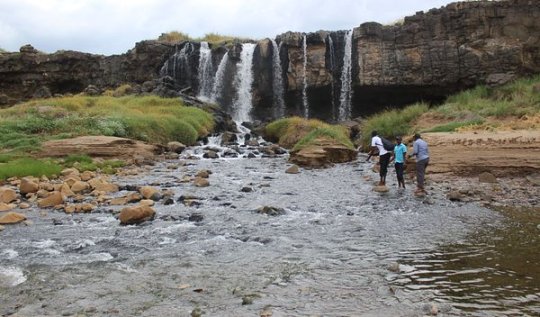
Away from the plus coast line is one of the most attractive geographical features of the country, there is more than half a million square kilometers of absolute marvel waiting for you if you look deeper into the country. The Rift Valley has so much to offer that we wouldn't exhaust its marvels in a whole book. Here are some of the uncommon/unknown/unexplored sites that will leave you breathless... Iten View Point Iten is a small town located about 50km north of Eldoret town. Although it is well-known as the home of Kenya’s world-class athletes, it also owes its reputation for great viewpoints of the Rift Valley, a geographical feature in East Africa The view point is one of the highest altitudes closest to escarpment where visitors view Kerio Valley. As the tarmac road meanders downhill, you get a perfect view of spectacular natural landmarks including the valley, Lake Kamnarok, Kerio River which hosts deadly crocodiles, Tugen Hills and Cherangani Hills. The magically laid out fault steps, steep escarpments and valleys covered with acacia vegetation paint a magnificent picture. Iten viewpoint allows you to see more of the Great Rift Valley than any other place on the ground. In fact, you can only see more of the Rift Valley if you are on a plane.
Kerio Valley and Kerio valley National Reserve Kerio Valley, one of the landmark features of the Great Rift, descends 4,000 ft, and is near the towns of Eldoret and Iten, The magically laid fault steps, steep escarpment facing and valley extensively covered with acacia vegetation paints a magnificent land on the Kenya Rift Valley. The floor of the Kerio Valley is covered by dry thorn bushes while the slopes have semitropical vegetation. Kerio Valley National Reserve offers a spectacular view of the Kerio valley in Kenya. You can also view the Torok Falls as well as the Chebloch Gorge while at the Kerio Valley National Reserve in Rift Valley part of Kenya. For the lucky few who happen to visit the reserve, you can experience the elephant migration via the Rimgoi reserve in Kenya Wildlife population including elephants, leopards and buffaloes, yellow baboons, bush backs, waterbucks and warthogs can be seen in the park. Kerio River Kerio River occupies the lowest level in Kerio Valley and hosts deadly Crocodiles. How Kerio River formed is extraordinary and mythical, Tugen and Keiyo communities have grounds to believe that long time ago, the two had undying boundary conflict and so a god locally known as Ilat became angry with the ongoing wrangles and stricken hard on the ground to demarcate Keiyo land from Tugen land hence end the dispute.
Rimoi Game Reserve
Its home to thousands of species of Rift Valley’s flora and fauna. Gazetted in 1983, the reserve boasts a variety of animals including elephants, buffalos and dikdiks. There are also impalas, monkeys, baboons. Bird life is abundant and various, with weavers, sunbirds, pigeons, honey guides, hornbills and turacos particularly prevalent
Saiwa Swamp National Park
Saiwa Swamp National Park is a forested paradise filled with exotic flowers, trees and bird. Arguably the smallest National Park in the Country, Saiwa Swamp gives the visitors a great chance to see one of nature’s peculiar creatures, the Sitatunga antelope which is semi aquatic. You can also see the white bearded De Brazza’s monkey that can only be found in this region. Within this tropical wetlands and mosaic of riverine forest, sedges and acacia woodlands, with fringing dense rushes and grass bedsBird life is abundant. Water birds include the lesser jacana, grey heron and the African black duck while the forest shelters the Narina trogons, the collared and orange-tufted sunbird, the yellow bishop, Hatlaub’s marsh widow bird and the Noisy Ross’s turacos which are difficult to miss.
Kipkoikoi Rock On the cliff side near Tambach, there towers a mythical Kipkoikoi Rock, a fairly cylindrical tip-pointed rock with a tabular platform at the foot. Our forefathers quips that Kipkoikoi Rock was a Holy Shrine of Keiyo people. This is where they used to offer sacrifices to Supreme Being locally known as Asis. They would pour some milk or lay some green grass on the tabular rock beside Kipkoikoi and have their sins forgiven and fortune go their way. It is also bluntly believed that none would dare climb up to top of such rock, or else it befalls on him or her.
Kolol Viewpoint
About 15 miles away from Iten town downhill, you’ll never hesitate to stop at Kolol Viewpoint. The tarmac road curves at a fairly level platform that provides an open view of fascinating Torok waterfall on escarpment on the South West direction and diminishing Lake Kamnarok. Just ahead, lays a ‘snake-like’ tarmac road meandering down to Chebloch Gorge on Kerio River before leading to Kabarnet town.
The Cherangani Hills
They are the fourth highest mountain range in Kenya and include rolling hills as well as dramatic mountain peaks, and forms the highest, most breathtaking and spectacular escarpments of the Rift Valley. Unlike most of Kenya's mountains and ranges, the Cherangani Hills are not volcanic in origin. They are centred upon a forested escarpment and surrounded on three sides by sheer cliff faces. They are criss-crossed by walking paths, and ease of direction and undemanding slopes make this excellent country for relaxing hill walking. The paths cross open farmland, pass through sheltered valleys and wind their way up to forested peaks. All the main routes cross the 3000m contour, with decreased oxygen supplies
Cherangani Hills Forest
This is a collection of thirteen forest reserve blocks on the western ridge of The Great Rift Valey. The forested area is about 1,200 square kilometres. These forests form the upper catchments of the Kerio and Nzoia and Turkwel rivers. Attractions include, Beautiful Landscapes and scenery, Plenty of wildlife and bird watching.
Kipteber Mountain
Popping from approximately five kilometers off the range of Cherangany hills is a huge, steep, rocky and extraordinary mountain..A Mountain barring an extraordinary narrative of its origin spanning lots of generations ago. Mt. Kipteber strategically sits on the Elgeyo/Marakwet- Pokot counties borderline
Chebloch Gorge
This gorge was cut down into the hard, basalt rock by the power of the Kerio River itself. When in flood, the river increases tremendously in height and volume and carries a heavy load of fine, highly-abrasive silt which grinds down the river bed. Steel beams of the old colonial-age bridge are close by and in place to offer a perilous perch from which to view the gorge. Below the bridge, usually about 20m below, much less in the rainy season, are the muddy brown, crocodile-infested waters of the Kerio River. Young boys with primitive fishing rods compete with the crocodiles for the mudfish and catfish that are seasonally abundant.
The Chalbi Desert
Chalbi desert is located in northern Kenya, east of Lake Turkana. Chalbi in the local Gabbra language means "bare and salty." It is among the hottest and most regions in Kenya, a salty pan surrounded by volcano and lava flows . Amazingly, you might still come across oryx, ostrich or even endangered Grevy zebra galloping across the great, shimmering whiteness. After the rains, the bone dry land turns into a shallow lake. On its northern fringes, where the wind piles up sand dunes, a chain of oases nourishes vast palm grooves.
Chyulu Hills
Chyulu Hills is located in Eastern Kenya, a mountain range that forms a 100Km long volcanic field. This destination is one of the prettiest places in Kenya, seeing the enchanted land of black frozen lava speckled with flaring poker trees is really something special. Ancient and new volcanic cinder cones and craters dot the landscape with black lava flow spilling down their flanks. Chyulu Hills provide to nature lovers. Large mammals include buffalo, bushbucks, elands, elephants, leopards, giant forest hogs, bush pigs, reedbucks and giraffes along with various reptiles and insects. Horse riding, camping, mountain climbing and bird watching can be enjoyed in this hidden part of paradise.
Kapsowar Kapsower is a beautiful small town located in Rift Valley Province, Kenya. It’s a picture-perfect town; filled with quaint charm, crisp breeze and amazing scenic beauty. It’s one of the best places to explore the most breathtaking landscapes and unique attractions such as charming flowing rivers, herds of cows and gorgeous hills.
Torok waterfall
Elgeyo Escarpment
Lake Turkana
One of the largest lakes in Africa, and the planet’s biggest permanent lake in a desert, Turkana lies in the Rift Valley, mostly in northern Kenya but with the tip running into southern Ethiopia. It is a spectacular place with some extraordinary landscapes, jade coloured waters, plentiful crocodiles, and incredible populations of massive Nile perch. It’s surrounded by some of the harshest terrain on earth where, somehow, some of the toughest but most delightful people manage to live too.
Loita Hills
The Loita Hills are one of Kenya's last remaining true wilderness areas which form an important part of the Maasai Mara Ecosystem. There are pockets of remote forests, wide open plains surrounded by the stunning hillsides. The escarpment is dotted with abundant wildlife and has a rich variety of different bird species. You can take a walking safari into the hills. Local people and their donkeys carry the luggage and the camp, leaving you free to explore the beauty of the hills and forests. Walking with people who live here is the best way to do it, and you’ll learn a huge amount about life in such a beautiful and remote place, one that’s truly off the map.
Olorgasailie
Olorgesailie pre-historic site is world renown as the "factory of stone tools" and the only place in the world with the largest number. The prominence and accumulation of human tools represents actual camping places of early men and evidence that human species had a tropical origin. The site is in a lake basin that existed about 100,000 to 200'000 years ago. Olorgesailie has excellently preserved biological and cultural evidence about the evolution of man. This was made possible by heavy falls of alkaline volcanic ash from the nearby Mt. Suswa and Mt. Longonot, which might have contributed much to the accumulated ash in the lake basin.
Mount Suswa
A true hidden gem, Mount Suswa is an excellent destination to add to your wish list, especially if you like camping. Another inactive volcano in the Rift Valley, Mount Suswa boasts a unique double-caldera, with an outer crater surrounding a second, inner peak. Hire local Maasai guide to help you find the road up to the crater, its isolation is a big part of Mount Suswa’s appeal. Its zigzagging hike along the outer crater rim will give you exceptional views of the volcano. Drive around the caldera to find Suswa’s famous lava tube caves and hike down into the caverns, which are full of bats, stalactites, and some interesting cave drawings of dubious origins. Not for the faint of heart, and not for those without a 4WD, Mount Suswa is a badge you’ll wear with honor.
Koobi Fora Historic Sites
Koobi Fora in the local language, means a place of the commiphora a source of myrrh, which is a common plant in this hot and arid area. The rich sedimentary rocks have yielded more than 10,000 Vertebrate and Hominid fossils. Most interesting here is a Stone Age burial site.
Loiyangalani Desert Museum
This museum was built on a bluff with a backdrop of Lake Turkana, the "Jade Sea." The name Loiyangalani means "a place of many trees" in the native Samburu language. The museum is hosted in this area by the El Molos, an almost extinct community in Kenya.
Kapedo hot springs
Two boiling hot waterfalls that plunge over a small escarpment before merging with Suguta river! Kapedo itself is a picturesque village where traditional grass thatched huts prevail. The surrounding has also a lot of charm with Silali volcano to the east and Tiati hills to the west which both are a rewarding hiking terrain. After walking the hills you can treat your tired legs with a swim in the huge bathing tub of Mother Nature, the warm waters of Suguta river. Whether you prefer it boiling hot or lukewarm, you will find the right water temperature depending on how close you are to the merger of the hot streams with Suguta river! Top holiday deals in Kenya
Best Deals on Major Seasonal Holidays – Valentine, Easter, Madaraka, Mashujaa, Jamhuri & Christmas. Variety of options – Safari adventures, Beach, Getaways & International. Only top-rated destinations & pocket-friendly prices.
Weekend Getaway Deals in Kenya
Self Drive Holiday Deals in Kenya
Outdoor Activities in Kenya
Madaraka Express SGR Holiday Deals in Kenya
Seasonal holiday Deals in Kenya
Top Self Drive Holiday Deals in Kenya
If you think you have to travel far to enjoy a nice weekend, you may never get away. Besides, you can enjoy a beautiful weekend right here in Kenya. There are countless wallet-friendly Kenyan self drive getaways that won’t even break your budget. Don’t spend your weekend, doing absolutely nothing at home. Whether you are looking for romantic destinations, pristine beaches, and adventurous outdoor activities, there are plenty wallet-friendly getaways that will satisfy your weekend desires.
Malindi & Watamu Self Drive Deals
Mombasa South Coast Self Drive Deals
Mombasa North Coast Self Drive Deals
Masai Mara Self Drive Holiday Packages
Lukenya & Machakos Self Drive
Meru Holiday Self Drive Deals
Mt. Kenya & Aberdare Self Drive Holiday Deals
Nyeri Holiday Self Drive Deals
Samburu Holiday Self Drive Deals
Read the full article
#magicalKenya#whyIloveKenya#adventuretravel#Kenyaholidays#Kenyavacation#placestovisitinkenya#toptraveldestinations#VacationinKenya
0 notes
Text
TANZANIA TOURS
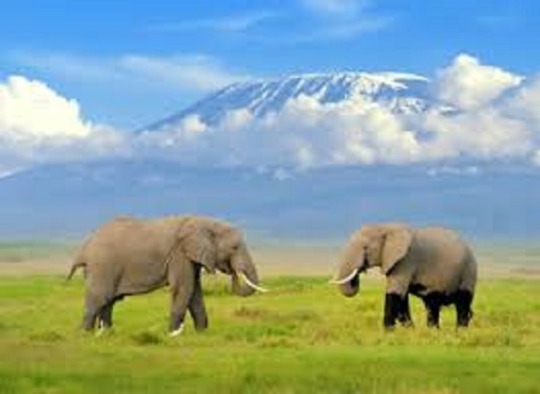
3 DAYS LAKE MANYARA, NGOROGORO CRATER & TARANGIRE PARK
This safari takes you to Lake Manyara, Ngorongoro Crater & Tarangire is designed to offer you a short but intense Tanzanian Northern Circuit safari experience. You will experience the excitement of game viewing in three of the most spectacular national game parks in Tanzania. Your tour will also take you to the Lake Manyara which is one of Tanzania’s most dramatically located wildlife areas consisting of a shallow but huge soda lake, at the foot of the Great Rift Valley’s western escarpment.
Day 1: Arusha to Lake Manyara National park
Non game-viewing travel time from Arusha: 2 ½ hours
Distance: 130 km
meet our professional tours guide/driver in Arusha town, who will deliver a short safari info briefing, after which, we travel to the Lake Manyara National Park. We arrive in time for lunch at the camp. After lunch we head into the Lake Manyara National Park.
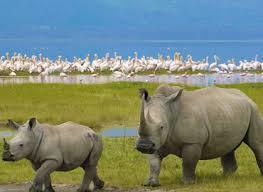
This impressive park is one of Tanzania’s most dramatically located wildlife areas, consisting of a massive but shallow soda lake (covering two-thirds of the park) at the foot of the Great Rift Valley’s western escarpment. The park’s varied habitat attracts a wide variety of animals, including one of Africa’s largest concentrations of elephants, Manyara’s famous tree-climbing lions, as well as large flocks of flamingos attracted by the algae in the lake.
Dinner and overnight at the camp.
Main Destination: Lake Manyara National Park
Accommodation: Budget camping
Meals & Drinks: Lunch & dinner (Breakfast not included), Drinking water (Other drinks not included)
Day 2: Lake Manyara National Park to Ngorongoro Crater
Non game-viewing travel time: 2 hours & 3 ½ hours
Distance: 60km & 155 km
After breakfast we descend 600m into this magnificent crater for a morning, half-day game drive.
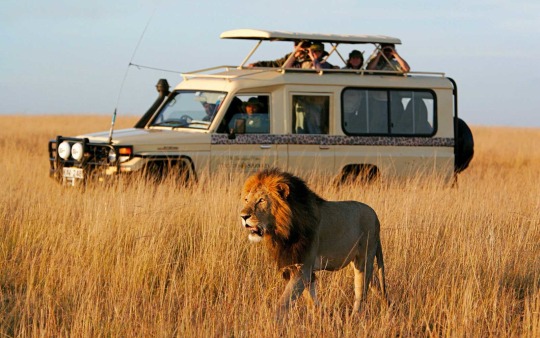
The Ngorongoro Crater is one of the most densely crowded African wildlife areas in the world and is home to an estimated 30,000 animals including some of Tanzania’s last remaining black rhino. Supported by a year round water supply and fodder, the Ngorongoro Crater supports a vast variety of animals, which include herds of wildebeest, zebra, buffalo, eland, warthog, hippo, and giant African elephants. Another big draw card to this picturesque national park is it’s dense population of predators, which include lions, hyenas, jackals, cheetahs and the ever-elusive leopard, which sometimes requires a trained eye to spot. We will enjoy a picnic lunch in the crater, after which we travel to the Tarangire National Park for an overnight. Dinner and overnight the camp.
Main Destination: Ngorongoro Crater
Accommodation: Budget camping
Meals & Drinks: All meals included, Drinking water (Other drinks not included)
Day 3: Tarangire National Park to Arusha
Distance: 120 km
After breakfast we shall have excessive game viewing session in this park, the park runs along the line of the Tarangire River and is mainly made up of low-lying hills on the Great Rift Valley floor.

Its natural vegetation mainly consists of Acacia woodland and giant African Baobab trees, with huge swamp areas in the south. Both the river and the swamps act like a magnet for wild animals, during Tanzania’s dry season. The Tarangire National Park is reputed to contain some of the largest elephant herds in Africa. This African national park is also home to three rare species of animals – the Greater Kudu, the Fringed-eared Oryx, as well as a few Ashy Starlings. We return to the lodge for lunch after which we will depart for Arusha town and we will end our African safari adventure.
You will be driven to your hotel, which ends marks the end of the safari.
Main Destination: Nairobi
Accommodation: No accommodation (End of tour)
Meals & Drinks: All meals included, Drinking water (Other drinks not included)
Visit us!! Now to Book at special discount!
#Best Kenya Safaris Tour Packages#Kenya & Tanzania Combined Tour Package#Best Kenya & Tanzania Tour Packages#Best Tanzania safari packages#Kenya safaris from Nairobi
0 notes
Photo
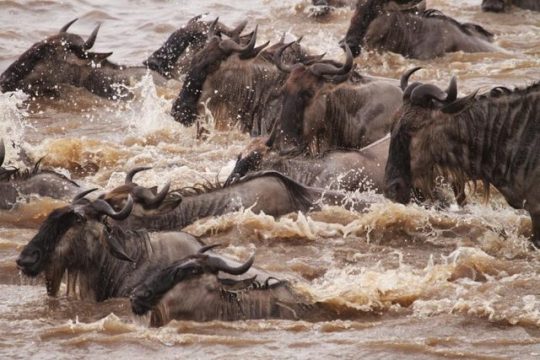
Our clients are always interested in “where do I go next” after they have visited Africa for the first time. The must do’s on your first trip are of course a game safari along with 2 of my personal favorites — Cape Town and the Cape Winelands. Our next recommendation would be to East Africa, specifically to see the migration of the wildebeest.
The timing of the migration depends upon the annual rainfall and if there are any fresh pastures which may occur earlier or later depending on the year. As water sources dry up in the South, there are over 1.5 million wildebeest that inspire this photographer’s dream itinerary to see the migration of the wildebeest along with thousands of zebras, gazelles and elands. Their predators — lions, cheetahs and leopards — are not too far behind tracking all the herds.
There is no fixed table of events. All depends on the coming of the rains, which can vary by several weeks, but in Serengeti National Park, light short rains usually fall in November and December, when the migrating wildebeest and zebra herds return to the southern Ndutu plains to crop fresh grass in the company of elands. In February, every day for about three weeks, an estimated 8000 newborn foals stagger to their feet within minutes of being dropped and follow their mothers. You are charmed by the spectacle of new life and certainly will be moved by this event.
The long rains in northern Tanzania occur between April and May when the grass plains blossom with short-lived flowering plants. Then the herds turn northward through the western Serengeti corridor and along the central outskirts. The Grumeti River crossing is a perilous trap in June and July, haunted by giant Nile crocodile.
To see this natural phenomenon, you can track and observe from 4×4 game-viewing vehicles, filming from the ground or in the air which allows you to zoom in on the action with your cast of wildebeest acting out their ancient ritual for you alone.
But this is just one of the many adventures that await you in East Africa — you can climb Mount Kilimajaro, travel the Mahale Mountains on a chimp trekking safari, or visit the 2 million year old wildlife dense Ngorongoro Crater. You can even spend the night at a coffee plantation!
If this sounds like what you are dreaming of for your next trip, please call us at 1-800-940-9344 or email us at [email protected] so we can begin turning your dream into reality.
0 notes
Text
8 Day Luxury Adventure in Serengeti and Ngorongoro Crater

Areas Visited: Arusha,Lake Eyasi, Lake Natron, Manyara National Park, Tarangire,Ngorongoro ,Olduvai Gorge and Serengeti National Park; Met on arrival at Kilimanjaro Airport, Transfer to Mvuli Hoteli for dinner and overnight
SAFARI DETAILS
Day 1: Tarangire National Park- game drive
After breakfast the tour departs. First stop is Arusha Town for any last minute purchases before we head off on safari. Afterwards we head towards the Tarangire National Park for a game drive with picnic lunch at the park. Tarangire is well known for its huge elephant population and baobab trees. It forms the centre of an annual migratory cycle that includes up to 3000 elephants, 25,000 wildebeest and 30,000 zebras.Ngorongoro farm house.: Lunch, dinner, bed and breakfast
Day 2: Lake Manyara National Park-Game drive
Non – game viewing time : 3 – 4 hrs
After breakfast, Kuwa Huru Adventure Tanzania driver will pick you up and depart to the Lake Manyara national park for a game drive. This national park is one of Tanzania’s most dramatically located wildlife areas, consisting of a massive but shallow soda lake (covering two-thirds of the park), located at the foot of the Great Rift Valley’s western escarpment. The park’s varied habitat attracts a wide variety of animals, including one of Africa’s largest concentrations of elephants, Lake Manyara’s unique tree-climbing lions, as well as large flocks of flamingos attracted by the algae in the lake. Late afternoon transfer to Lake Eyasi Safari Lodge
Lunch, dinner, bed and breakfast
Day 3: Lake Eyasi-Get to Know- Bushmenand Hadzabe Tribe
Today it’s time to interact with the Bushmen, the Hadzabe Tribe, who live in groups hunting with bow and arrows and gathering roots, tubers and wild fruits much as humankind lived in the Stone Age. We will get in depth look at how they continue to survive and how they adapt to their harsh environment and the challenges they face to continue this nomadic existance. The Datoga tribe are blacksmiths, a trade developed over centuries and still practiced in vary much the same way today. They produce the arrow heads for the Hadzabe and brass trinkets, some of which will be for sale by maker himself. Late afternoon transfer to Ngorongoro Gibb’s Farm
Lunch, dinner, bed and breakfast
Day 4: Lake Eyasi- Ngorongoro crater-Game Drive
Non – game viewing time : 3 – 4 hrs
After breakfast, drive to Ngorongoro Conservation Area, You will descend over 600 meters into the crater to view wildlife. Supported by a year round water supply and fodder, the Ngorongoro National Park supports a vast variety of animals, which include herds of wildebeest, zebra, buffalo, eland, warthog, hippo, and giant African elephants. Another big draw card to this picturesque national park, is it’s dense population of predators, which include lions, hyenas, jackals, cheetahs and the ever-elusive leopard, which sometimes requires a trained eye to spot. We will visit Lake Magadi, a large but shallow alkaline lake in the southwestern corner, which is one of the main features of the crater. A large number of flamingos, hippos and other water birds can usually been seen here. Dinner and overnight at Ngorongoro Serena Lodge Lunch, dinner, bed and breakfast
Day 5: Ngorongoro crater – Serengeti National Park
Non – game viewing time : 2 – 3 hrs
Early morning break fast and after depart to Serengeti National Park. We will stopover at Olduvai Gorge, boasting with a history dating back to the dawn of time. It was here, that the anthropologists Dr. Lois and Mary Leakey discovered the skulls of ‘Nutcracker Man’ and ‘Handy Man’, both very significant links in the chain of human evolution. Do game drive in Serengeti and overnight at the heart of Serengeti Seronera Nasikia tented tented Camp Lunch, dinner, bed and breakfast
Day 6: Serengeti National Park- Full day game drive
Full day Serengeti National Park game drive including following the wildebeest migration. Dinner and overnight at Serengeti Kati Kati Tented Camp. Lunch, dinner, bed and breakfast
Day 7: Serengeti National Park – Lake Natron- game drive
Non – game viewing time : 4 – 5 hrs
After an early breakfast, Do a morning game drive then after do a game en route towards north Serengeti. Check out of the park at Klein’s gate then transfer to Lake Natron for an early dinner and over night. Go for an evening lake Natron walk for sunset if time permits. Dinner and overnight at Lake Natron tented camp. Lunch, dinner, bed and breakfast
Day 8: Lake Natron – Arusha
Non – game viewing time: 3 – 4 hrs
Night ascent & dawn summit bid, Oldoinyo Lengai (seismic conditions permitting). Optional waterfall hike and swim (Depending on what time your flight is leaving). After transfer to Arusha for airport drop off or overnight.
SAFARI RATES
Group size
1 person
2 persons
3 persons
4 persons
5 persons
6 persons
7 persons
Price per Person
$ 10,674
$ 5,693
$ 4,409
$ 3,389
$ 3308
$ 3,211
$ 3,174
PRICE INCLUDES
Transportation in 4×4 safari vehicle
Professional, English speaking guide
Meals:Breakfast, Lunch & Dinner
Mineral water
Overnight stays in Safari Lodges / Luxury Tented Camps
All national park fees
PRICE EXCLUDES
Alcoholic and soft drinks
Visa fees
Tips
Personal spending monies for souvenirs etc.
Travel insurance
Any other expenses that are not in the “include list” above
Read the full article
0 notes
Text
7 days Serengeti and ngorongoro crater(mara crossing

7 days Serengeti and ngorongoro crater(mara crossing)
Great Migration
The journey for the main players in the Great Migration, the roughly two million wildebeest, begins in the south of the Serengeti with the birth of half a million calves between January and March. A favorite time of year for many of the veteran Serengeti guides, the air is filled with new life and action during these months. Read all about Africa's largest wildlife event on this page. 7 days Serengeti
OVERVIEW
A 7 Day Serengeti and Ngorongoro Safari gives you the opportunity to fully explore Ngorongoro Crater/Conservation Area and Serengeti National Park on this 7 Day Tanzania Safari, a week-long safari itinerary through Northern Tanzania that combines these two northern parks circuit covers big weights.
Why do wildebeest migrate?
The 800-kilometer migration of the giant herd of wildebeest is the largest mammal migration on earth. The timing of the migration coincides with the greening of nutritious grasses on the short-grass plains during the rainy season. These areas are safer as predators can be easily spotted, making them an ideal place for calving. However, the plains are drying up and the wildebeest are forced to move to the western corridor in search of greener pastures. The northern extension of the ecosystem has the highest rainfall, but the grasses are the least nutritious. This is the wildebeest's dry season retreat, at least until the south turns green again. The result is a clockwise motion from south, west, north, and back south. 7 days Serengeti
The Great Migration in short
You won't find a better representation of the cycle of life anywhere else in the world. The journey begins in the southern Serengeti when wildebeest calves are born. Predators like lions and hyenas are constantly chasing after babies, and thousands and thousands of calves are born within a few weeks, eye candy for true nature lovers. When the drought comes in May, the herd moves north towards the Masai Mara in Kenya, feeding on the tall green grass, followed quickly by the gazelle and zebra. The migration is not without risk: crossing rivers means confronting some 3,000 crocodiles patiently awaiting a kill. Not to mention the Serengeti's famous lion population: by far the largest in Africa. Despite the area's abundance of huffle fish, life for these big cats in this unforgiving landscape is not easy. But seeing a group of lions working together to hunt a wildebeest is a sight to behold. Then, with the onset of short rains in late October, the migration makes its way back to the Serengeti. By December, the herds pass Seronera – a small settlement in central Serengeti where the official Serengeti Visitor Center is located – to return to their calving grounds, and the circle closes.
The Great Migration in detail
When planning your Serengeti safari, you probably want to see the Great Migration. So how do you make sure you're there when it happens? The long and short of it is, you can't. It's important to know that deciding when to visit the Serengeti always involves some risk. We've detailed the Great Migration below, and that usually happens, but remember there are no guarantees. The annual migration of two million ungulates, wildebeest but also huge groups of zebra and Thomson's gazelle, Grant's gazelle and eland Serengeti National Park is the largest animal spectacle of its kind in Africa and perhaps even in the world. Although there is some variation from year to year, the Serengeti migration follows a reasonably predictable annual cycle, dictated by local precipitation patterns. The Great Migration Cycle is divided into the following periods:
December-April
The main calving areas are found in the area southeast of Seronera: the typical Serengeti plains extend into the Ndutu area near Ngorongoro. The reasons for their move to this area are the brief rains in November and December. The wildebeest stay in this area until the end of the long rainy season, late April, early May. The good news is that this section of Serengeti National Park is easily accessible and the scenery becomes lush during this time. February is usually calving season in the Ndutu region and the south-eastern plains: the best time to visit this region. With so many wildebeest, zebra and other ungulates giving birth to so many calves, the spectacle acts as a magnet for predators. As early as March or April, the herd can move again in search of greener pastures. It's harder to see actual migration during this time, but chances are you'll encounter very large herds along the way.
May-July
This is the time when the wildebeest, after feeding on the short green grasses of the southeastern Serengeti and giving birth to their offspring, begin to prepare for their 800-kilometer migration. The actual start date can be anytime between late April and early June. This is the time when you might have the privilege of seeing one of the world's greatest natural phenomena: more than a million marching animals in a column up to 40 kilometers long. During migration, the herd moves towards the western corridor, where they will encounter the first major obstacle: crossing the Grumeti River. Many animals do not survive the crossing as the local population awaits them with oversized crocodiles ready to feed. The herd may congregate on the south bank of the river and remain there for up to two weeks before crossing the river.
August-September
When the obstacle of the Grumeti River is overcome, the herd moves further north and in July or August they start crossing the next big hurdle, the Mara River. So many iconic photos of the Great Migration were taken at the crossing of the Mara River. After this crossing, the herd flock to the north-western plains and the Masai Mara National Reserve in Kenya. The August-September period is considered a bad time to visit Serengeti National Park and see the Great Migration when the herd moves to the Masai Mara in Kenya. However, migration patterns show that about half of the herd stays on the Tanzanian side in the Mara Serengeti area. During this time, smaller herds of wildebeest (keep in mind that small herds can number anywhere from 500 to thousands of individuals) frequently cross the Mara River back and forth for no apparent reason. This is an excellent time to stay at one of the Serengeti Mara Camps.
October-November
Crossing the Mara River in a northerly direction means that the herd must cross the river once more at one point before beginning the return march southwards. This usually happens in October, but sometimes earlier. During this time the herd traverses the northern plains and the Lobo area. This section of the Serengeti National Park is little visited. So if you want to watch the migration in relative calm, now is the time. The wildebeest return to the short grass plains and calving grounds around Ndutu in late November. And from here the Great Migration starts all over again.
Note
As previously mentioned, the times described on this page are guidelines as exceptions are common. In November 2013, the wildebeest were already beginning their trek back to the short grass plains of the southern Serengeti when rain suddenly started north of the Mara River. Nature is like nature and the herd turned back to the Masai Mara in Kenya. The herd stayed there for about three weeks before continuing their journey south. A year later, in 2014, unusual rains in the southern Serengeti resulted in much of the herd being left behind and not making the journey north towards the Western Corridor until July.
When to visit?
It is up to you whether you want to plan your Serengeti safari around the Great Migration. We have already mentioned that the Serengeti is a year-round destination as it covers a vast area and offers unparalleled wildlife viewing. The chances that you are at the exact spot where the Great Migration herd crosses a river (either the Grumeti or the Mara River) are very slim. The timing of the herd movements cannot be guaranteed either. However, if you choose the right part of the Serengeti: the South East and Ndutu from December to May, the Western Corridor from May to July, the Serengeti Mara area from July to October and the Northern Serengeti and Lobo area from October to November should large herds of wildebeest and their entourage can easily be found.
Welcome to tarangire national park
For those pressed for time, this two day, one night safari features two of Tanzania's most popular national parks. You'll have the chance to see the Big Five and more when you travel to these two beautiful parks. Tarangire National Park is one of the top national parks in Tanzania, nestled between the Maasai Steppe to the southeast and the Great Rift Valley lakes to the north and west. The park covers an area of 2600 sq km and is well known for its great diversity of wildlife species with amazing accommodation for tourists to rest when they are on Tanzania safari tour. Tarangire National Park is located in Tanzania and is one of the national parks in northern Tanzania. This destination is just a short drive from Arusha and is close to other wildlife viewing destinations such as Lake Manyara National Park. The name Tarangire, after which the national park is named, comes from the Tarangire River, which crosses the park. Various wildlife species drink from the river, which is a major source of water for the animals, especially during the dry season.
ATTRACTIONS IN TARANGIRE NATIONAL PARK
The distant Silale Swamp is one of the features of the Tarangire ecosystem. During the green season, the swamp acts like a large sponge, absorbing water and slowly releasing it during the dry season. Huge herds of herbivores flood the park in search of water, alternately attracting lion, leopard and wild dog. Silale swamp lions, African wild dogs, Cape buffalo and even elephants call these wetlands home. Donaldson's Nightowl, Smith's Vulturine Guinea Fowl are some of the bird species that can be seen in this area
The giant baobab tree
The baobab tree, popularly known as the tree of life, is another feature found in Tarangire National Park. The baobab has adapted to its environment over time. It's a succulent, meaning it collects and stores water in its massive trunk during the rainy season, allowing it to produce nutrient-rich fruit during the dry season, when all else is dry and barren. As a result, it was nicknamed the "Tree of Life." It has a gigantic trunk that can hold up to 300 liters of water. They have a long life expectancy and can live up to 600 years. The edible seeds of this tree are an important food source for a wide variety of animals. Elephants, on the other hand, sharpen their massive tusks on the bark of these trees. According to legend, these trees could easily roam across the African continent, but God was irritated by their aimless movement, so he decided to place them upside down to prevent them from moving again.
Birding in Tarangire
Enjoy seeing a variety of beautiful and rare bird species during your vocation in Tarangire National Park. The Tarangire swamps are home to around 550 different bird species. Tarangire is a well-known safari spot for bird lovers who engage in it for a long period of time. Crested Francolin, Hoopoe, Yellow-necked Spurred Fist, Hornbills, Guinea Fowl, Steppe Eagles, Brown Parrots, Giant Crested Vulture, White Bellied Bird, Caterpillar Eagles, Mousebirds, Kori Bustard, Yellow-Collared Turtle Doves, Bee-eaters are some of the bird species that you will see during your safari in Tarangire-Tanzania can watch.
The Wildlife Migration in Tarangire
Tarangire is one of the most seasonal parks in northern Tanzania, with a lot of migratory activity around Tarangire. Tarangire is about 120 kilometers from Arusha, near the southeast corner of Manyara National Park. During the dry season from June to October, most of the Tarangire region is completely dry and few water sources remain. Incredibly large herds of various animals migrate to the park as they are drawn to the waters of the Tarangire River. This massive wildlife migration, although not as well known as the annual wildebeest migration in the Serengeti, sees elephant, hartebeest, wildebeest, gazelle and zebra, as well as predators such as lion and leopard, flock to the park in large numbers. Make this park a part of your northern Tanzania safari as the vegetation is sparse and arid allowing for excellent wildlife viewing.
Tanzania’s elephant population
Tarangire is one of the most seasonal parks in northern Tanzania, with a lot of migratory activity around Tarangire. Tarangire is about 120 kilometers from Arusha, near the southeast corner of Manyara National Park. During the dry season from June to October, most of the Tarangire region is completely dry and few water sources remain. Incredibly large herds of various animals migrate to the park as they are drawn to the waters of the Tarangire River. This massive wildlife migration, although not as well known as the annual wildebeest migration in the Serengeti, sees elephant, hartebeest, wildebeest, gazelle and zebra, as well as predators such as lion and leopard, flock to the park in large numbers. Make this park a part of your northern Tanzania safari as the vegetation is sparse and arid allowing for excellent wildlife viewing.
Poacher’s Hide
The poachers' hideout in Tarangire National Park is a must-see attraction. It is located southwest of Tarangire Hill, about a hundred meters west of the park's main north-south road. The poachers' hideout is a famous old baobab tree with a slightly hidden entrance and an inner chamber that was formerly used by poachers as a hideout. Poachers Hide's baobab tree is around 10 meters in diameter and believed to be over 300 years old, making it one of the oldest trees in Tarangire National Park.
Lemiyon Triangle
This is another must-see attraction during your safari in Tanzania's Tarangire National Park. Massive baobab trees and huge flocks of red-billed quelea birds can be found in Lemiyon. Nestled in the northernmost reaches of the park, this pristine site forms a triangular zone. The mightiest baobabs, towering down the road with their colossal silvery trunks and multitude of gnarled branches, are the most prominent form of vegetation here. Lemiyon is excellent for spotting raptors, and even non-birders will be surprised by the abundance of these powerful aerial carnivores.
Tarangire River
The Tarangire River is an important feature in Tarangire National Park and serves as a water source for the park's ecosystem and is a fantastic spot for wildlife viewing as animals congregate on the riverbanks to drink water, particularly during the Dry Season Safaris in Tarangire National Park, the Tarangire River is a haven for many animals including a sizable concentration of elephants who come to the riverbanks to drink water and cool off from the scorching sun. Elephants digging on the sands near the Tarangire River to get underground water have been sighted. Leopard, lion, wildebeest, zebra, buffalo and gazelle are among the creatures that can be spotted along the banks of the Tarangire River.
Matete Woodlands
Matete offers excellent leopard viewing as well as the chance to see the unusual gemsbok. The towering elephant grass and spiky reeds that grow along the riverbanks on the western side of the region give the site its name. Matete is the best place in the park to regularly see leopards. These mysterious cats are often seen among the branches of acacia tortilla trees.
Kitibong Hill
Kitibong Hill is a stunning area in Tarangire National Park that is home to huge herds of Cape buffalo and endangered wild dogs. During a Tanzania safari in Tarangire National Park, you can watch cape buffalo fling their huge, humped horns and swoop across the area's acacia plains. The spectacular African wild dogs can be seen in groups of 6 to 20 in this Kitibong Hill area. Travelers who visit Tarangire National Park during a Tanzania safari have the opportunity to see and learn about these attractions around the park. For a truly unforgettable safari experience in Tanzania and Africa, choose Focus East Africa Tours to take you on a safari to Tarangire National Park.
0 notes
Text
5 Day Tanzania Wildlife
5 Day Tanzania Wildlife Safari Family Tour in Tanzania, this safari trip will take you to Tanzania most visited destinations, Lake Manyara National Park, Serengeti National Park and Ngorongoro Conservation area.

Day One: Arusha to Lake Manyara
Pick up from Arusha and transfer to Lake Manyara national park, We arrive in time for lunch at the lodge and after lunch do we head into the Lake Manyara National Park for an afternoon game drive. This national park is one of Tanzania’s most dramatically located wildlife areas, consisting of a massive but shallow soda lake (covering two-thirds of the park), located at the foot of the Great Rift Valley’s western escarpment. The park’s varied habitat attracts a wide variety of animals, including one of Africa’s largest concentrations of elephants, Lake Manyara’s unique tree-climbing lions, as well as large flocks of flamingos attracted by the algae in the lake.
Day Two: Lake Manyara to Serengeti Plains
After breakfast we head towards the Serengeti National Park, via the beautiful high lying farmland of Karatu and the Ngorongoro Conservation Area. Leaving the highlands behind, we descend into the heart of wild Africa – the Serengeti National Park – with its endless plains, rolling into the distance as far as the eye can see. We head to the central park area, known as the Seronera area, one of the richest wildlife habitats in the park, featuring the Seronera River, which provides a valuable water source to this area and therefore attracts wildlife well representative of most of the Serengeti’s species, We arrive in time for lunch and enjoy an afternoon game drive in the Serengeti national park.
Day Three: Serengeti Full Day Game
Morning game viewing drive along the Sogore River Circuit, which loops into the plains south of the Seronera River, and which is good for possible Lion, Thomson gazelle, topi, ostrich and cheetah sightings. The Visitor Centre close to the Serengeti Seronera Lodge and public campsites is well worth a visit after the morning’s game drive. This nicely designed center offers some interesting wildlife displays as well as a gift shop selling information leaflets and maps of the area. The center also has a shop where cold drinks and snacks can be purchased, as well as a picnic area and information trail up and around a nearby kopje. We will enjoy a relaxed picnic lunch at the center in the shade of the giant acacia trees; in the afternoon we will follow the Kopjes Circuit, which goes anti-clockwise around the Maasai Kopjes, which usually attract a number of lion and some formidably large cobras. Kopjes are weathered granite outcrops, scattered around the plains, most of which are miniature ecosystems, providing shade and drinking water in pools left in the rock after the rains. This makes the kopjes particularly good for spotting wildlife in the dry seasons – including lions, which like to lie in wait for animals coming to drink.
Day Four: Serengeti to Ngorongoro crater
After breakfast at the lodge do we depart to Ngorongoro Conservation area? We will stopover at Olduvai Gorge, boasting with a history dating back to the dawn of time. It was here, that the anthropologists Drs. Lois and Mary Leakey discovered the skulls of Nutcracker Man and Handy Man, both very significant links in the chain of human evolution, We arrive in time for lunch at the lodge and after lunch we will descend over 600 meters into the crater to view wildlife for a half day’s safari tour. Supported by a year round water supply and fodder, the Ngorongoro National Park supports a vast variety of animals, which include herds of wildebeest, zebra, buffalo, eland, warthog, hippo, and giant African elephants. Another big draw card to this picturesque national park is its dense population of predators, which include lions, hyenas, jackals, cheetahs and the ever-elusive leopard, which sometimes requires a trained eye to spot. We will visit Lake Magadi, a large but shallow alkaline lake in the southwestern corner, which is one of the main features of the crater. A large number of flamingos, hippos and other water birds can usually been seen here.
Day Five: Ngorongoro crater to Arusha
Enjoy breakfast, after which we will transfer back to Arusha. Upon arrival in Arusha will we have lunch and then we will end our Tanzania safari adventure. The group should tip the guide around $20 a day, Will drive back to your hotel in Arusha.
0 notes
Photo
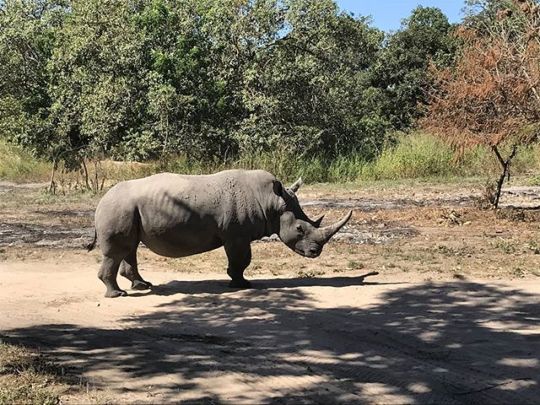
We often have a chance to stop at the Fathala wildlife reserve in the Sine Saloum of #Senegal before we cross into the #Gambia. The reserve plays an important role in species conservation, and it is one of the only places in #westafrica where you can see Rhinocerous and the Western Giant Eland. #tbt #wildlife #adventure -- 📷 @kellzilla907 who was on our two week trip to Bissau and the Bijagos Islands — view on Instagram http://bit.ly/2Qjsz9D
0 notes